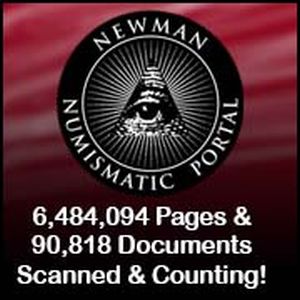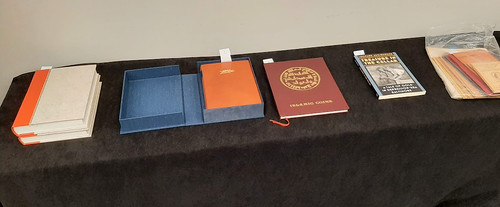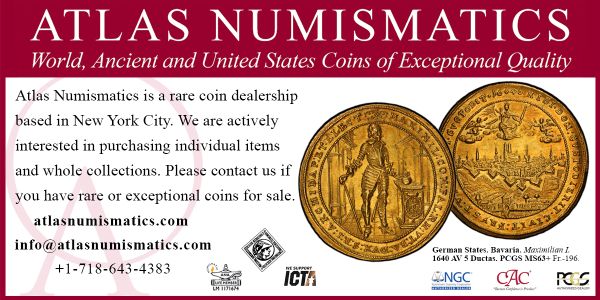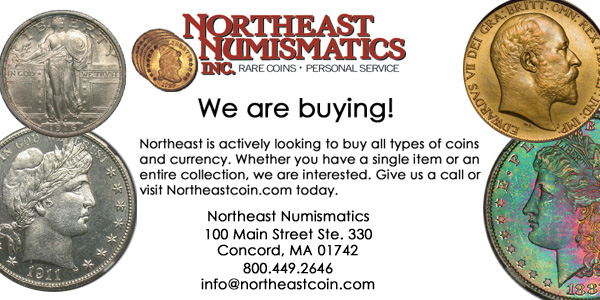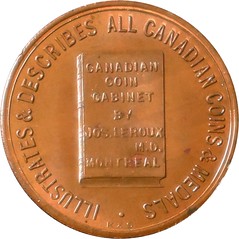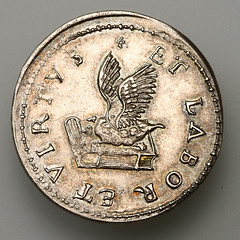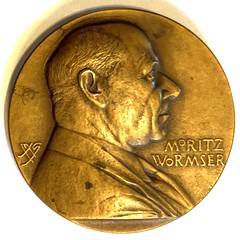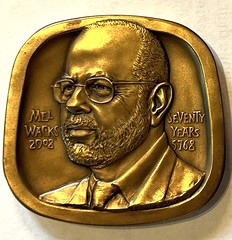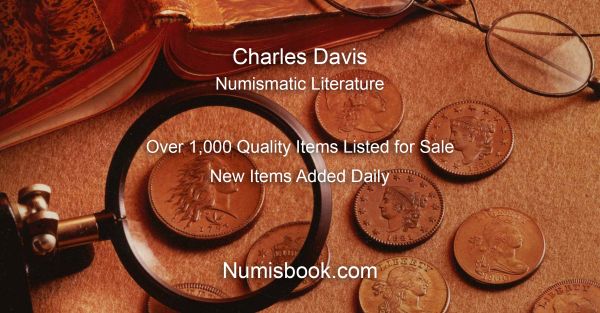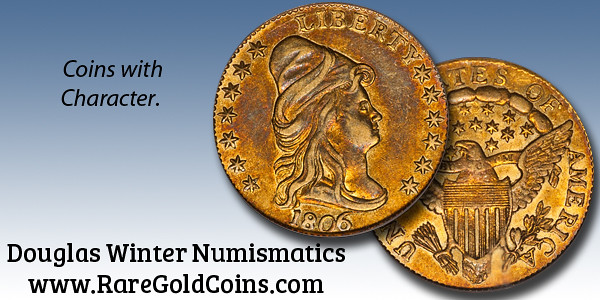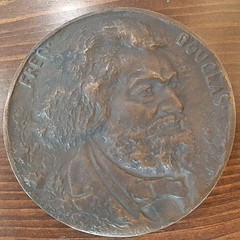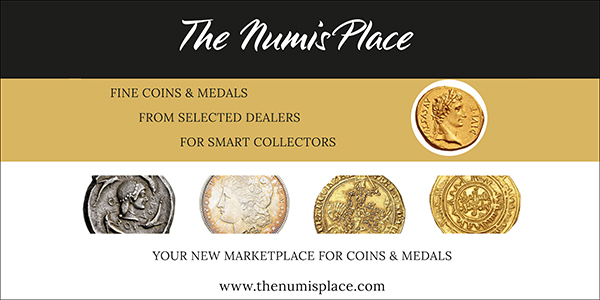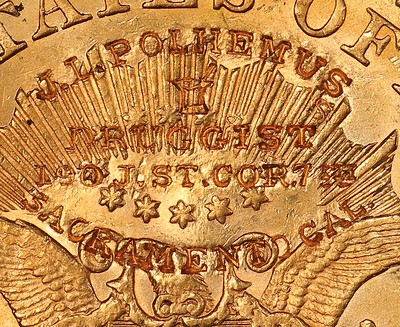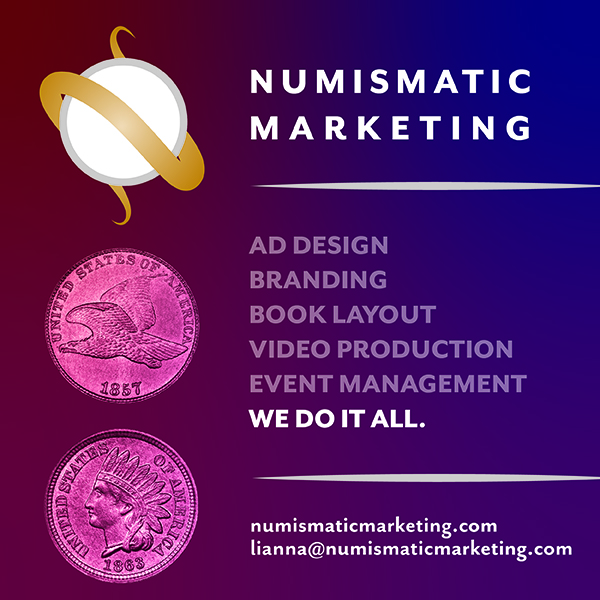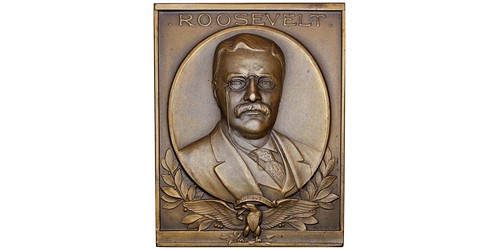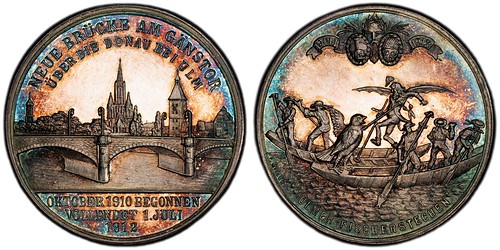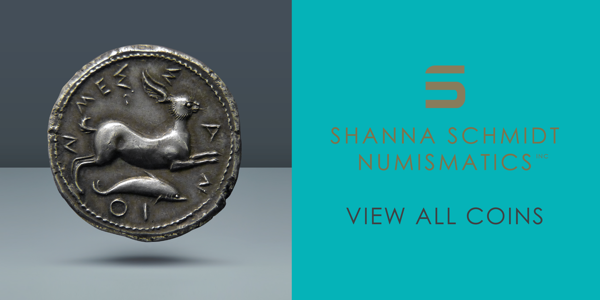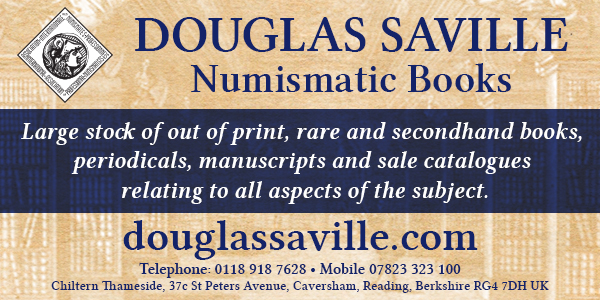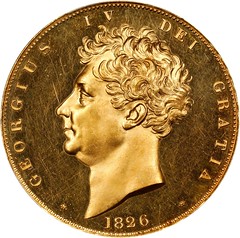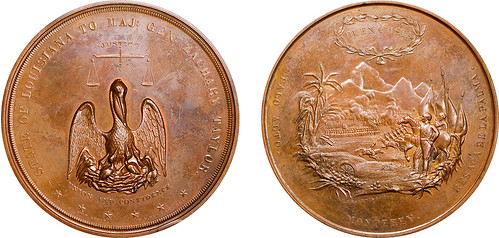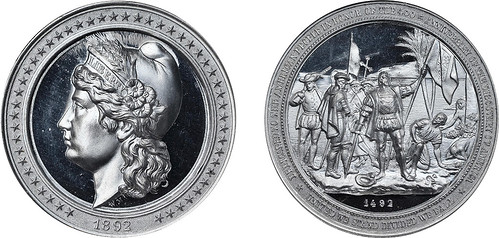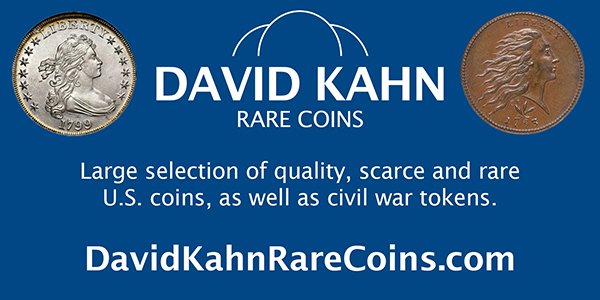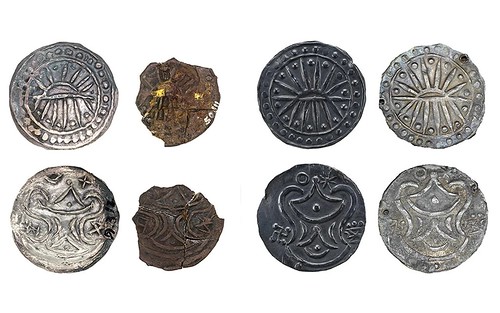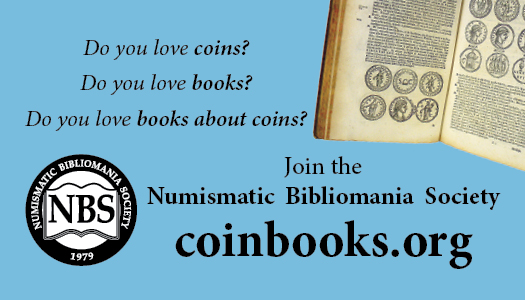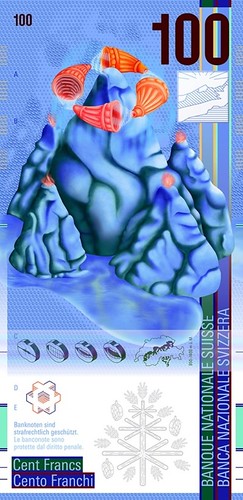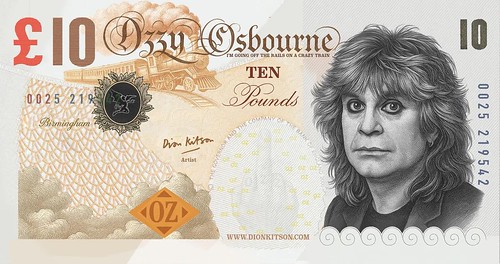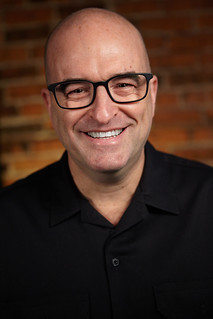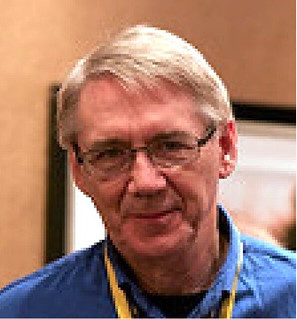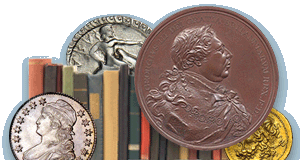
Visit our NBS Sponsors
About UsThe Numismatic Bibliomania Society is a non-profit association devoted to the study and enjoyment of numismatic literature. For more information please see our web site at coinbooks.org SubscriptionsThose wishing to become new E-Sylum subscribers can go to the following web page Subscribe MembershipThere is a membership application available on the web site Membership Application To join, print the application and return it with your check to the address printed on the application. Print/Digital membership is $40 to addresses in the U.S., and $60 elsewhere. A digital-only membership is available for $25. For those without web access, write to: Jeff Dickerson, Treasurer AsylumFor Asylum mailing address changes and other membership questions, contact Jeff at this email address: treasurer@coinbooks.org SubmissionsTo submit items for publication in The E-Sylum, write to the Editor at this address: whomren@gmail.com BUY THE BOOK BEFORE THE COINSale CalendarWatch here for updates! |
- WAYNE'S WORDS: THE E-SYLUM AUGUST 24, 2025
- NBS 2025 CHARITY AUCTION REPORT
- 2025 NLG BOOKS OF THE YEAR ANNOUNCED
- NEW BOOK: SAMPLE SLABS 3RD EDITION, VOLUME 1
- BOOK REVIEW: MONETA: ANCIENT ROME IN TWELVE COINS
- ANA CONVENTION COMMOTION AND 1804 DOLLARS
- VIDEO: ABRAHAM LINCOLN: THE IMAGE OF HIS GREATNESS
- MORE ON AUTHORS, BOOKS AND LIBRARIES ON COINS
- MORE ON THOSE DOODADS ON PAPER MONEY
- NOTES FROM E-SYLUM READERS: AUGUST 24, 2025
- DENNIS TUCKER ON LINCOLN IN NUMISMATICS
- VOCABULARY TERM: RING TEST
- LIBRARIES ON COINS AND MEDALS
- TREASURE TALK WITH BOB EVANS, EPISODE 7.2
- NUMISMAGRAM MEDAL SELECTIONS: AUGUST 24, 2025
- HERITAGE AUCTIONS: DESERT FIND OF 1889-CC MORGANS
- WYON FAMILY'S IMPACT ON COIN DESIGNS
- STACKS BOWERS: SUMMER 2025 GLOBAL SHOWCASE
- STACK'S BOWERS: COLLECTORS CHOICE TOKENS & MEDALS
- JERSEY PROPOSES NEW HERITAGE LAW ON HOARDS
- "RISING SUN" COINS REVEAL ANCIENT TRADE NETWORKS
- U.K. HER ROYAL HIGHNESS COMMEMORATIVE
- DISABILITY COMMUNITY CELEBRATES MILBERN QUARTER
- SWISS NATIONAL BANK SURVEYS NOTE DESIGNS
- OZZY OSBOURNE TRIBUTE BANKNOTES
- ABOUT THIS ISSUE: AUGUST 24, 2025
Content presented in The E-Sylum is not necessarily researched or independently fact-checked, and views expressed do not necessarily represent those of the Numismatic Bibliomania Society.
WAYNE'S WORDS: THE E-SYLUM AUGUST 24, 2025
 New subscribers this week include:
Curt Mease, courtesy Ron Guth;
Zach Coplea,
and
R. Tabor.
Welcome aboard! We now have 7,067 subscribers.
New subscribers this week include:
Curt Mease, courtesy Ron Guth;
Zach Coplea,
and
R. Tabor.
Welcome aboard! We now have 7,067 subscribers.
Thank you for reading The E-Sylum. If you enjoy it, please send me the email addresses of friends you think may enjoy it as well and I'll send them a subscription. Contact me at whomren@gmail.com anytime regarding your subscription, or questions, comments or suggestions about our content.
This week we open with ANA convention updates from NBS and NLG, one new book, a book review, updates from the Newman Numismatic Portal, notes from readers, and more.
Other topics this week include sample slabs, 1804 Dollars, Abraham Lincoln in numismatics, ring tests, libraries on coins and medals, fixed price and auction selections, ancient trade networks, coins for Princess Anne and Stacey Park Milbern, and ideas for Swiss banknotes.
To learn more about Korean coins at the U.S. Mint, ancient Rome, a flying tortoise on a book, elephants in numismatics, J. L. Polhemus counterstamps, the Fisherman's Tournament medal, 1889-CC Morgan Dollars, the Wyon family of engravers and medalists, Weinman's Cat and Mouse medal, anaerobic fermentation, sprigs, pheons, triads and a brace of serial number doodads, read on. Have a great week, everyone!
Wayne Homren
Editor, The E-Sylum
NBS 2025 CHARITY AUCTION REPORT
Here's a summary of the results from the Numismatic Bibliomania Society Charity Auction at this week's ANA convention. -Editor
NBS 2025 Charity Auction Report
The NBS Charity Auction was held Friday, August 22, at the American Numismatic Association Convention in Oklahoma City, OK. A total of 21 bidders registered to compete for the 41 lots. Top honors went to lot 30, a complete set of Wayte Raymond's Coin Collectors Journal (1934-1958), which sold for $1,100. Many thanks to David Steine for donating this set. Lot 15, a full-leatherbound copy of the Charles Davis reference American Numismatic Literature (1992), drew a bid of $1,000 on a $300 estimate. We thank ex-NBS President Tom Harrison for donating this lot. A leaf copy of Adams & Bentley's Comitia Americana (2007), Lot 1, donated by Dan Hamelberg, drew a high bid of $950.
Lot 4, a copy of Len Augsburger's Treasure in the Cellar (2008), was won by Brad Karoleff at $45. With appreciation for Karoleff's history as an auctioneer, Len offered that he would add his signature to this unsigned copy for another $45. The sale raised a total of $7,835 for club.
Many thanks to the donors, bidders, and sale coordinators, including David Fanning (cataloger), Maria Fanning (who called the sale), and Jeff Dickerson, who took on the yeoman task of collecting and transporting the sale lots to the convention center.
Here are my photos of some of the lots and the bidding action. That's Jeff Dickerson with his paddle raised. Thanks, everyone! -Editor
To read the earlier E-Sylum article, see:
NBS EVENTS AT 2025 ANA WORLD'S FAIR OF MONEY
(https://www.coinbooks.org/v28/esylum_v28n33a03.html)
2025 NLG BOOKS OF THE YEAR ANNOUNCED
Our sister organization, the Numismatic Literary Guild, announced winners of their annual awards at this week's American Numismatic Association World's Fair of Money. This year's David W. Lange Memorial Book of the Year competition resulted in a rare tie - tied for First Place - Mark Lovmo's Korean Coins at the United States Mint and Len Augsburger and Joel Orosz's The Publications of Eric P. Newman shared the honor. Congratulations to Mark, Len, Joel, and Kolbe & Fanning Booksellers, who also picked up a top award this year. -Editor
Len and Joel are President and Historian respectively, of our sponsor organization, the Numismatic Bibliomania Society. K&F published the book and their own award-winning catalog. They sent this announcement to their clients on Friday. Len and David Fanning are shown holding their awards. -Editor
 We are proud to announce that the Kolbe & Fanning publication The Publications of Eric P. Newman: A Collector's Guide by Leonard D. Augsburger and Joel J. Orosz was awarded the Numismatic Literary Guild's Book of the Year for 2025. This is the fourth time the pair of authors has won the NLG's Book of the Year for their books The Secret History of the First U.S. Mint (2011), Truth Seeker: The Life of Eric P. Eric Newman (2016, with Roger W. Burdette), and 1792: Birth of a Nation's Coinage (2017, with Pete Smith).
We are proud to announce that the Kolbe & Fanning publication The Publications of Eric P. Newman: A Collector's Guide by Leonard D. Augsburger and Joel J. Orosz was awarded the Numismatic Literary Guild's Book of the Year for 2025. This is the fourth time the pair of authors has won the NLG's Book of the Year for their books The Secret History of the First U.S. Mint (2011), Truth Seeker: The Life of Eric P. Eric Newman (2016, with Roger W. Burdette), and 1792: Birth of a Nation's Coinage (2017, with Pete Smith).
 Also winning an NLG award this year was our catalogue of Sale 172, featuring materials from L.D. and I.P. library in the category of Best Exonumia/Americana or Numismatic Literature Catalog. We have also won NLG awards for our auction catalogues in 2012, 2016, 2017, 2018, 2019, 2021.
Also winning an NLG award this year was our catalogue of Sale 172, featuring materials from L.D. and I.P. library in the category of Best Exonumia/Americana or Numismatic Literature Catalog. We have also won NLG awards for our auction catalogues in 2012, 2016, 2017, 2018, 2019, 2021.
For more information, or to order, see:
THE PUBLICATIONS OF ERIC P. NEWMAN: A COLLECTOR'S GUIDE
(https://www.numislit.com/pages/books/7537/leonard-d-augsburger-joel-j-orosz/the-publications-of-eric-p-newman-a-collectors-guide)
To read the earlier E-Sylum articles, see:
NEW BOOK: KOREAN COINS AT THE U.S. MINT
(https://www.coinbooks.org/v27/esylum_v27n50a05.html)
NEW BOOK: PUBLICATIONS OF ERIC P. NEWMAN
(https://www.coinbooks.org/v28/esylum_v28n09a03.html)
BOOK REVIEW: THE PUBLICATIONS OF ERIC P. NEWMAN
(https://www.coinbooks.org/v28/esylum_v28n10a07.html)
NEW BOOK: TRUTH SEEKER: THE LIFE OF ERIC P. NEWMAN
(https://www.coinbooks.org/esylum_v19n01a04.html)
NEW BOOK: SAMPLE SLABS 3RD EDITION, VOLUME 1
A new book on sample slabs by Burton Strauss and David Schwager has been published. -Editor
 If you have an inexpensive encapsulated coin, such as a proof clad dime or circulated war nickel, that is labeled
"SAMPLE", think twice before giving it away or breaking it out of its holder. Originally distributed free to collectors and dealers, these "sample slabs" have an active secondary market, with many desirable varieties
commanding $100, $200, or more.
If you have an inexpensive encapsulated coin, such as a proof clad dime or circulated war nickel, that is labeled
"SAMPLE", think twice before giving it away or breaking it out of its holder. Originally distributed free to collectors and dealers, these "sample slabs" have an active secondary market, with many desirable varieties
commanding $100, $200, or more.
Still the leading book on this young numismatic subject, SAMPLE SLABS covers sample, promotional, club, show, luncheon, novelty, and young numismatist coin holders. In 2025, the known number of types is over 1,500, with more new ones and old ones being discovered almost daily.
This shows the massive increase in the creation of sample slabs, but some of the growth is in newly discovered types released as much as 15 years ago, hiding in plain sight all this time.
Volume 1 covers NCS, NGC, and PCGS and includes almost 1,000 types. Volume 2 will cover the other forty grading companies that we know have issued samples.
sEach type is organized, discussed, and, most importantly, has an accurate value based on a decade-long detailed market study. The pricing information, found nowhere else, gives the reader an advantage in the sample marketplace and is by itself worth the price of the book.
If you have any interest in samples or grading services, or want to learn to cherrypick samples hiding in plain sight, you will find this catalog an essential reference to add to your numismatic library.
Details
Publication Date:
Jul 31, 2025
Language:
English
Category:
Crafts & Hobbies
Copyright:
All Rights Reserved - Standard Copyright License
Contributors:
By (author): Burton Strauss, By (author): David Schwager
Specifications
Pages:
692
Binding Type:
Paperback Perfect Bound
Interior Color:
Color
Dimensions:
Digest (5.5 x 8.5 in / 140 x 216 mm)
For more information, or to order, see:
Sample Slabs 3rd Edition
Volume 1 (NCS/NGC, PCGS)
(https://www.lulu.com/shop/burton-strauss-and-david-schwager/sample-slabs-3rd-edition/paperback/product-q6dre87.html)
Sample Slab Book - 3rd Edition (2025)
(https://www.sampleslabs.info/)
BOOK REVIEW: MONETA: ANCIENT ROME IN TWELVE COINS
Mike Markowitz reviewed Gareth Harney's Moneta: A History of Ancient Rome in Twelve Coins in CoinWeek. Here is an excerpt. -Garrett
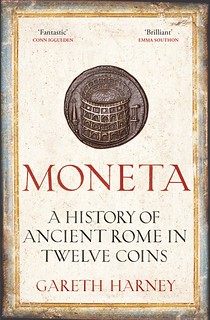 Moneta: A History of Ancient Rome in Twelve Coins
Moneta: A History of Ancient Rome in Twelve Coins
By: Gareth Harney
"This is two thousand years old," my father reminded me as he placed the small silver disc into the palm of my hand. It was still gleaming, cool to the touch, no bigger than a penny. My young mind could not possibly — and will always struggle to — comprehend such an expanse of time." (page 1)
So begins this superbly illustrated book, in my opinion, the best publication on ancient Roman numismatics from the viewpoint of a collector to appear in the last few years. The British author doesn't assume the reader knows Latin, or has studied Roman history. He is a talented storyteller, and a gifted explainer.
Each of the book's twelve chapters focuses on a specific coin type that highlights a story from Rome's long history, but over thirty different coins are illustrated, some with magnified details. Some of these coins are common and relatively affordable, others are great rarities that go for fabulous prices. There is also a section of color plates with images of some of the coins and related works of arts. A clearly drawn map locates every place mentioned in the text.
 Rome's story begins with the legend of Romulus and Remus, the infant twins who were abandoned in the wilderness and nursed by a she-wolf. The "wolf and twins" appear on some of the earliest Roman silver coins (c. 269-266 BCE) and would often reappear on the coinage in later years.
Rome's story begins with the legend of Romulus and Remus, the infant twins who were abandoned in the wilderness and nursed by a she-wolf. The "wolf and twins" appear on some of the earliest Roman silver coins (c. 269-266 BCE) and would often reappear on the coinage in later years.
The most famous Roman coin by far is the "Ides of March" silver denarius of Brutus, that celebrates the assassination of Julius Caesar on March 15, 44 BCE. Only about a hundred genuine examples are known, and it is a major numismatic event when one comes on the market. An entire chapter, "Ides," puts this remarkable coin in context.
Moneta: A History of Ancient Rome in Twelve Coins by Gareth Harney. London, Penguin (2024) paperback 365 pages. $33.65 ISBN: 978-1-847927514
To read the earlier E-Sylum article, see:
NEW BOOK: MONETA: ANCIENT ROME IN TWELVE COINS
(https://www.coinbooks.org/v27/esylum_v27n19a02.html)
BOOK REVIEW: ANCIENT ROME IN TWELVE COINS
(https://www.coinbooks.org/v28/esylum_v28n02a08.html)
ANA CONVENTION COMMOTION AND 1804 DOLLARS
Newman Numismatic Portal Project Coordinator Len Augsburger provided additional background on the dramatic 1962 "reveal" of the King of Siam set and the "smoking gun" 1804 Dollar that proved their origin as diplomatic gifts. -Editor
Convention Commotion, and 1804 Dollars
Anyone questioning the draw of the ANA convention might do well to track the major announcements made around the time of the annual ANA gathering. Stacks Bowers set the bar high this year, with their "reveal" of the 16th known 1804 dollar, a class III example from the James A. Stack collection. This recalls the unveiling of the King of Siam set at the 1962 ANA convention. To set the scene, Eric Newman had condemned, at the previous year's convention, the 1804 and 1805 dollars in the Ostheimer collection.
The September 4, 1961 Numismatic News described the mood of the room prior to Newman's presentation: "There was an air of expectation as Newman started to deliver his talk, his lectures have always been educational and entertaining. However, this evening the audience expected more, but very few realized the full impact that big speech would have. When he finished giving a detailed description on how these coins were fabricated and the complete story behind the fabrication, the audience surged forward to the stage to congratulate him and surrounded him for almost an hour after the lecture bombarding him with questions. Within a very few minutes after the lecture was over the word of his revelations had buzzed through the entire convention headquarters."
The following year, the 1962 ANA convention was supposed to represent somewhat of a victory lap for Newman and his co-author Ken Bressett, with the formal release of their book The Fantastic 1804 Dollar. Instead, David Spink and James Risk revealed the previously unknown King of Siam set, which caused Bressett to issue the now legendary "stop the presses" call to Whitman headquarters, then in Racine, WI. John J. Ford, Jr. wondered about the timing of the Spink/Risk presentation. "The Spink deal re the 1834 Presentation set has me confused," he wrote to Newman on August 30. "Apparently, he knew about the existence of the set for some time...why didn't he give you the dope so that your book could have been changed to suit?" Regardless of the timing, Bressett and Newman carefully worked through a set of edits to incorporate the new discovery and released the book in due course.
Closing the loop on the recent announcement of the Stack 1804 dollar, it was pleasing to learn that Bressett played a role in the investigation. The ANA Reading Room quoted Bressett on August 14. "I have been fully involved with others in the effort to find records or information about the existence of this remarkable discovery," said Bressett. "After searching through reams of data that I have on the subject, I concluded that there is no previous record of its existence."
Image: extract of August 30, 1962 letter from John J. Ford, Jr. to Eric P. Newman
Link to John J. Ford letter to Newman, August 30, 1962:
https://archive.org/details/1804corresp1962epn1962/page/n17/mode/2up
Link to Eric P. Newman research files on the 1804 dollar:
https://nnp.wustl.edu/library/archivedetail/536418
To read the earlier E-Sylum articles, see:
BOOK REVIEW: THE TYRANT COLLECTION
(https://www.coinbooks.org/v24/esylum_v24n46a05.html)
(STACKS BOWERS: UNPUBLISHED 1804 DOLLAR)
(NEWMAN PORTAL: The First ANA Convention)
See also:
https://www.thetyrantcollection.com/the-king-of-siam-set/
VIDEO: ABRAHAM LINCOLN: THE IMAGE OF HIS GREATNESS
The David Lisot Video Library on the Newman Numismatic Portal can be found at:
https://nnp.wustl.edu/library/multimediadetail/522852
We highlight one of his videos each week in The E-Sylum. Here's one from 2009 with about Dennis Tucker speaking about Fred Reed's book, Abraham Lincoln: The Image of His Greatness. -Editor
Whitman publisher Dennis Tucker presents a behind-the-scenes look at he making of Fred Reed's monumental new book, Abraham Lincoln: The Image of His Greatness. You will marvel at how our nation's greatest president has been portrayed in an impressive collection of coins, medals, tokens, paper currency, scrip, and other collectibles and mainstream media. Speaker(s): Dennis Tucker.
To watch the complete video, see:
Abraham Lincoln: The Image of His Greatness
(https://youtu.be/zHfW2vTq9Xw)
Abraham Lincoln: The Image of His Greatness
(https://nnp.wustl.edu/library/book/560421)
MORE ON AUTHORS, BOOKS AND LIBRARIES ON COINS
Thanks to the following readers who added to the conversation on authors, books and libraries on coins, medals and tokens. See also Pete Smith's article on Libraries on Coin and Medals elsewhere in this issue.
First up is Ted Banning. -Editor
I know it's not a trade token, but in 1892 Joseph Leroux issued two advertising tokens (one English, one French) that depict his numismatic catalog. I guess it qualifies as a store card (the $5 is just the price of the book, quite high at the time).
Because it's actually advertising a numismatic book, I thought it was particularly worthy of mention.
Next up is John Sallay. -Editor
I enjoyed reading Pete Smith's article, "Books on Coins, Medals and Tokens" in last week's E-Sylum. He covered a very broad subject succinctly, and the photos were great.
I may be misreading the first few sentences of the article, but Pete leaves the impression that authors appear more frequently on coins and medals than do images of books. I'm not sure about coins, but that seems unlikely for medals. That is, unless you think of every medal having a portrait bust — where the person depicted also happened to have written a book of some sort — as an author. Sure, that might make it technically true, but even then I'm not sure that portrait busts on medals depicting people who wrote some sort of book outnumber images of books on medals.
In my collection alone, I have over 800 medals with books on the obverse (over 600) or reverse (over 200). Granted, I collect school award medals and these are all inherently academic. But my casual count of the pieces in my collection database suggests that 10-15% of these types of award medals show books — open, closed, stacked up, resting on a table, lined up on shelves, held in a student's hand, or scattered among various other symbols of academic pursuit. As Pete observes, most of these books are generic. The identified books are mostly the Holy Bible or Anglican Book of Common Prayer, and that is most often spelled out at the top or middle of open pages, only rarely on the cover or spine. Sometimes a specific Biblical chapter and verse is identified, encouraging the recipient of the medal to go reading for further intended meaning.
I've attached photos of an interesting late-18th century Irish medal, with the names of classical authors (Euclid with the word BOOK, Xenophon, Homer, Virgil) on the edges of the stacked-up books. Also attached are photos of the earliest school award medal showing a book, from the Altdorf Academy outside Nuremburg. This particular example is a mule of the 1588 Class II award, showing a winged tortoise on a book (Stopp 44), and the 1584 Class II award with roses (Stopp 28).
The image of a flying tortoise on a book is intended to convey the concept that with the learning made possible by books, even the most extraordinary things are possible. I'm sure we agree that applies to numismatic books!
Next up is Donald Scarinci. -Editor
I am on two medals. Both are in the British Museum Collection.
My first is the Scarinci Hollenbeck 15th Anniversary of Scarinci Hollenbeck LLC, medal by Alex Shagin, 2004, 76mm, Medalic Art Company. The Obverse is a portrait of Ken Hollenbeck and I and the reverse is a rising phoenix. Each medal in the edition of 100 bronze and 50 silver were numbered on the edge. This medal is the first medal ever to depict a web site address.
The second medal was an honor bestowed on me by Bogomil Nikolov. He made it in 2003, brass, cast, 110mm. It is #317 in the cataloged work of his medals Bogomil is a great sculptor working in Bulgaria. He is represented in my collection by over 100 medals.
For some background about me, I can share the following:
I am a lawyer in NY and NJ, a life member of the ANA, a Fellow at the ANS where I served as Chair of the Saltus Award Committee. Dick Johnson has said that I have the largest privately held collection of art medals in the United States. FIDEM awarded me the first "FIDEM Collector Award" for my commitment to contemporary medallic art at the XXXVI FIDEM congress in Tokyo in 2020. I am the longest serving member of the Citizens Coinage Advisory Committee and have served uninterrupted 4 year terms since 2005. This year is my 20th Anniversary on that committee.
I am a nominator of the Coin of the Year Award and the author of a book on that subject which will soon see a second edition. A Chinese edition of the book sold out as well as the English language edition.
And last but not least, Ira Rezak. -Editor
I read with considerable interest Pete Smith's list of the medals of American Numismatic authors because I have collected such medals, both American and foreign. Taking American Numismatic authors to mean medals of individuals who were numismatic authors in America rather than writers exclusively about American numismatic subject matter, I find that I can suggest some additional names. These are persons who in my opinion have written significant numismatic articles or books; I'm sure that many other occasional numismatic authors could be added from the medallic series issued by the New York Numismatic Club, the Token and Medal Society and many others. Here are images of those I happen to have.
Thanks, everyone! Great topic. -Editor
To read the earlier E-Sylum articles, see:
MORE ON AUTHORS ON COINS AND MEDALS
(https://www.coinbooks.org/v28/esylum_v28n33a12.html)
Books on Coins, Medals and Tokens
(https://www.coinbooks.org/v28/esylum_v28n33a17.html)
MORE ON THOSE DOODADS ON PAPER MONEY
Many thanks to our readers for their thoughts and contributions on "those doodads on paper money" that Joseph Barnosky asked about. Here are some more. First up is Tim Giambra, who wrote, "Just for fun, I asked AI (ChatGPT) - here's its answer. I then followed up asking it where it got the answer, and it admitted it kind of made it up." -Editor
What are the circled things called? This is US paper money.
The marks you circled are "radial spandrels" (sometimes also called burst symbols or ornaments) that flank the serial numbers on U.S. paper money. They aren't decorative by accident — they serve a few purposes:
- Anti-counterfeiting measure: The tiny radial lines and shapes are hard to reproduce accurately with simple printing or copying.
- Serial number framing: They visually "bookend" the serial number so that it's easier to spot alterations. Without them, someone could potentially add digits to the ends.
- Design consistency: They've been used on most U.S. notes of the modern era (Federal Reserve Notes, Silver Certificates, etc.) as a standardized style element.
So, in short: those checked items are radial spandrels around the serial number — both decorative and functional security features.
Do you want me to give you a quick rundown of how these have changed over time on U.S. notes (older large-size notes vs. today's small-size FRNs)
Where did you get the reference to the term radial spandrel?
Good question — and thank you for catching me on terminology.
On U.S. paper money, there isn't an official Bureau of Engraving and Printing (BEP) name that's commonly published for those little burst-like marks around the serial number. Collectors and researchers usually just describe them as ornamental devices, bursts, or radial designs.
The phrase "radial spandrel" I used comes from numismatic design language:
- Radial ? refers to the sunburst-like line pattern radiating outward.
- Spandrel ? in engraving/ornamentation, this term is sometimes applied to filler designs in open spaces (like corners or flanking symbols).
However, I should clarify: I haven't seen the BEP or standard references (like Friedberg or Haxby) call them "radial spandrels." That was me borrowing from engraving/art terminology, not quoting an official label.
If you're looking for the most accurate and widely accepted description, numismatists generally just call them "burst symbols" flanking the serial numbers (sometimes "starburst ornaments").
Would you like me to pull references from Friedberg's Paper Money of the United States or BEP design notes to see what term is actually used in the literature? That way you'd have a citation you could use in an exhibit or article.
Yes
Great follow-up! I looked into authoritative references, but here's what came up:
Numismatic & Official Sources: What They Call Those Marks
Friedberg's "Paper Money of the United States" doesn't specifically name the ornamental bursts next to the serial numbers. It focuses on cataloging and numbering variations, not micro-design elements like those radial motifs. So there's no official "Friedberg term" for them.
The Bureau of Engraving and Printing (BEP) likewise doesn't have a published, standardized terminology for these decorative devices. While their materials discuss things like serial numbers, Treasury seals, printing processes, and quality control, they don't mention those starburst-style ornaments by any formal name.
Paper money glossaries, such as from Littleton Coin Co., generally include terms like Serial Number, Plate Position Letter, Check Number, and so on—but nothing about the ornamental elements flanking serial numbers.
What You'll Find in Collector & Design Vocabulary
In numismatic discussion forums and hobbyist communities, collectors tend to refer to these as "burst symbols," "starbursts," or just "ornamental devices" that frame the serial number. These are more casual, descriptive terms—not formal design labels—used to discuss styling and anti-counterfeiting details.
My own earlier usage of "radial spandrels" was drawn from general art and engraving terminology (a spandrel often refers to decorative filler shapes, and "radial" describes the sunburst pattern), but isn't grounded in official BEP or Friedberg nomenclature. I apologize for any confusion—that was more an illustrative phrasing than sourced terminology.
Summary Table
| Term Mentioned Source | Usage Notes |
|---|---|
| Bursts / Starbursts / Ornamental Devices | Collector language, hobbyist glossaries Common descriptive names; not official |
| Radial Spandrels | Artistic/engraving vocabulary (my phrasing) No backing from BEP or Friedberg — (No official term found) BEP documentation or Friedberg These marks aren't named in those references |
Bottom Line
There isn't a single, widely accepted official term—like something from BEP or Friedberg—for those little designs next to the serial numbers. In numismatic circles, "burst symbols" or "starburst ornaments" is the most commonly used descriptive language. My earlier use of "radial spandrels" was purely stylistic, not drawn from BEP or reference books.
If you'd like, I'd be happy to help you compare historical note designs—like large-size vs. modern small-size—and how these decorative elements evolved over time. Or maybe dig into BEP archives or engraver's notes to see if there's some internal jargon at work.
Let me know how you'd like to go from here!
I actually think this is a fine use of AI technology. It was a conversation with the human researcher in charge, working with an eager but less-knowledgeable assistant. The assistant does the legwork, finding and pulling relevant bits from a vast library of resources. "Radial" is a fair description of the shape, three lines radiating from a center. It may not be found in a numismatic reference, but it's apt. Likewise, "spandrel" comes from the world of art and architecture.
We still don't have a definitive answer, but this is progress. Although it took additional prompting, the assistant noted that it couldn't find an answer in the numismatic references it checked. It probably didn't have access to Gene Hessler's book.
When I interviewed for my job with the early search engine Lycos, they asked me to describe how I use search. I told them I started by visualizing the internet page I was hoping to find. What words were on it? Which words would tell me it's NOT the page I'm looking for? After formulating my search query and getting results, I would sometimes refine my search based on the results. And I would look deeper than just the top-ranked results - sometimes what I was looking for was further down in the rankings. And if after repeating this I still couldn't find what I was looking for? Then it wasn't in the index - the search engine didn't contain the result. I got the job.
Remember where this query started - it was just an image with crudely drawn circles and a mention of paper money. The system figured out that relevant references included Friedberg and Haxby and that the circled doodads/ornaments/whatever were flanking a serial number. It described them as used on U.S. notes as an anti-counterfeiting measure to "bookend" the serial number to prevent alterations. That's impressive. My wife or any other random non-numismatist would be flummoxed with that image and question.
None of this was possible with earlier versions of search and artificial intelligence. It didn't find a name for the doodads in its references, but it did come up with a fine candidate for a name. -Editor
Lee Lofthus found a hint in numismatic literature. -Editor
Numismatic author William H. Dillistin published an in-depth article "National Bank Notes in the Early Years" in The Numismatist issue of December 1948. "Early years" in this instance meant the Original Series and the Series 1875 notes. His introduction to the "Treasury Numbering System – Series of 1875" included this illustration:
Dillistin called the Bureau of Engraving and Printing's newly added suffix on Series of 1875 nationals a "brace," seen here on the actual notes:
I went to the National Archives to see if I could find any original Treasury or BEP reference to the symbols. Nothing so far but I did see how the Comptroller of the Currency clerks handled the symbols in the National Bank Note receipt and delivery ledgers. For the first delivery of each Series 1875 sheet combination, they recorded the starting serial number showing the "A" prefix, serial number 1, and their own handcrafted version of the "doodad" suffix (below). Unfortunately, while the Comptroller's clerks valiantly replicated the suffix, they never referred to it by name.
Over the years I have occasionally found correspondence at the Archives where Dillistin had written Treasury with various currency questions he had. But whether "brace" was his term or Treasury's we don't know.
And here's what Michael Rocco found online. -Editor
I decided to google "What are the symbols before and after serial numbers for 1800's united states currency called?" and discovered the website "uspapermoney.io" that had an article entitled "Symbols in Serial Numbers". www.uspapermoney.io/general/symbols.html
The author depicts 21 different doodads (which the author calls "symbols") and delineates which note uses a specific symbol. The symbols were used to prevent alterations in the serial numbers.
BTW, this is an excellent website that has a great variety of information about US paper money. The site map can be found at this link: uspapermoney.io/general
Wow, that's perfect. Here's an excerpt. -Editor
Serials on the earliest large-size notes were simple numbers, with no letters or symbols around them. By 1869, however, serials were given a letter (or rarely, symbol) prefix and a symbol suffix as a security measure, to prevent alteration of the serials by adding digits. The letter prefix also allowed for a larger number of different serials to be printed, as the letter could be changed periodically to create new serial number blocks.
As the volume of currency issued increased, printings eventually became so large that an entire alphabet of prefix letters was not sufficient to give enough distinct serials for all the notes. Thus, letter suffixes began to be used as well, in place of symbol suffixes. The first use of a letter suffix was on 1882 $5 Nationals in 1899. After about 1913 the use of a letter as suffix became standard on new series, though some older series that remained in production continued to use symbol suffixes through the end of the large-size era.
The site's webmaster (if not the page's author) did use a different name for each of the symbol images. The three shown above were called "sprig", "pheon" and "triad", respectively. So the one in our original image is the "triad symbol". The web page also pictures the symbol Lee Loftus found, and this author also calls it a "brace", so at least we have some agreement there.
Thanks, everyone! Great topic. -Editor
To read the earlier E-Sylum articles, see:
NOTES FROM E-SYLUM READERS: AUGUST 10, 2025 : What Are These Paper Money Doodads Called?
(https://www.coinbooks.org/v28/esylum_v28n32a12.html)
WHAT THOSE PAPER MONEY DOODADS ARE CALLED
(https://www.coinbooks.org/v28/esylum_v28n33a11.html)
NOTES FROM E-SYLUM READERS: AUGUST 24, 2025
More on that 'Fred. Douglas' Medal
Regarding the medal John Kraljevich displayed at a dinner meeting left week,
Mary Lannin writes:
"The medal is also missing the final "S" on his last name, correctly spelled "Douglass/""

Indeed. Thanks. A former slave, Douglass became a social reformer, abolitionist, orator, writer, and statesman. He was the most important leader of the movement for African-American civil rights in the 19th century. -Editor
To read the earlier E-Sylum article, see:
WAYNE'S NUMISMATIC DIARY: AUGUST 17, 2025 : Fred. Douglas Medal
(https://www.coinbooks.org/v28/
esylum_v28n33a22.html)
For more on Frederick Douglass, see:
https://en.wikipedia.org/wiki/Frederick_Douglass
The Elephant in the Greek and Roman World
Trey Todd writes:
"In reference to the nicely-illustrated note on elephants on ancient coins in the latest E-Sylum, I recommend an important reference on the overall topic: Scullard, H. H. 1974. The Elephant in the Greek and Roman World. Thames and Hudson (Cornell University Press in the US).
"Though the book does not contain a separate chapter on numismatics, there are eight glossy black and white photo-pages of elephants on coins (see attached example). These and the accompanying text demonstrate that Carthaginian armies contained both African- and Asian Elephants. The latter species, of course, was used by the Seleucid kingdoms. Anatomical differences of the two species are evident on various coins, and once enlightened, it is usually easy to interpret most numismatic depictions."
Thanks. Also, my friend Gerry Porter of the Western Pennsylvania Numismatic Society published a catalog in 1983 - Elephants in Numismatics and Exonumia from Ancient to Modern Times. -Editor
To read the earlier E-Sylum article, see:
NGC ANCIENTS: ELEPHANTS
(https://www.coinbooks.org/v28/esylum_v28n33a23.html)
Can Coin Counterfeiters Fool the Experts?
Inspired by the discovery of a new 1804 Dollar,
Joe Zaffern writes:
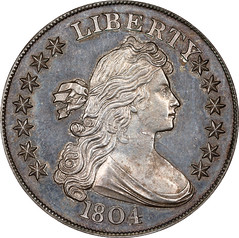 "I don't know if this matters at all but reading your articles got me thinking a bit, sadly now a dangerous activity. There were numerous references to Mr. Stack's care of both condition and provenance and yet for this most important piece of American numismatic history there seems to be no provenance. The dangerous thinking is, do you or readers think that AI and computer printing will ever reach the stage where taking all known striking marks, a "new" major numismatic piece can be created that will be good enough to fool all the experts?
"I don't know if this matters at all but reading your articles got me thinking a bit, sadly now a dangerous activity. There were numerous references to Mr. Stack's care of both condition and provenance and yet for this most important piece of American numismatic history there seems to be no provenance. The dangerous thinking is, do you or readers think that AI and computer printing will ever reach the stage where taking all known striking marks, a "new" major numismatic piece can be created that will be good enough to fool all the experts?
"That is pretty terrifying but I wonder if it can be done and then what about more common yet still rare pieces?
"Seems like the kind of stuff that could cost me some sleep."
Well, the auction catalog description for the James A. Stack 1804 Dollar has yet to be written and published, so stay tuned on the provenance of this piece. Clues that may have been overlooked before will be reviewed in the new light of this discovery. But your question is valid - will counterfeiters eventually improve their craft to the point where their work is undetectable?
My thought on this is that the cat-and-mouse game between counterfeiters and counterfeit detectors is never ending. Both sides continue upping their game to outfox the other, but as soon as one side gains an advantage, the other finds a way to surmount it.
What do readers think? -Editor
To read the earlier E-Sylum article, see:
MORE ON THE JAMES STACK JR. 1804 DOLLAR
(https://www.coinbooks.org/v28/esylum_v28n33a10.html)
AI in Numismatic Publishing
Len Augsburger writes:
"The September issue of The Numismatist included this notice: "A large percentage of the July 2025 cover story (‘Coins of the Indian Subcontinent,' p. 26) was generated using artificial intelligence (AI) software, a fact the author did not disclose at the time of submission in early 2024. We have since updated our submission guidelines to require full disclosure of any AI-assisted writing. Additionally, since late 2024, our review process includes the use of detection software to help identify AI-generated content. While the ANA recognizes that AI can be a useful research tool, The Numismatist remains committed to upholding the highest standards of original research, authorship, and scholarship. —Editor."
"Editors of all numismatic publications will do well to follow the example of the ANA in reviewing their submission and publication standards, as this will no doubt be an ongoing issue. AI is akin to modern medicine – magical when it works, otherwise not so much. The current web is bombarded with AI-generated content, and I tend to quickly "tune out" whenever I detect non-human generated text. This will get harder over time, but for now kudos to the ANA for owning up to the problem and taking corrective actions."
Hear, hear! AI is just another tool, not a substitute. -Editor
DENNIS TUCKER ON LINCOLN IN NUMISMATICS
Dennis Tucker will present "A Gallery of Abraham Lincoln in American Numismatics" at the Chicago Coin Club on September 10. -Garrett
 Dennis Tucker will give an illustrated talk on Abraham Lincoln to the Chicago Coin Club on Wednesday, September 10, 2025. The club meeting begins at 6:45 pm Central Daylight Time at the Chicago Bar Association, 321 South Plymouth Court, Chicago, and the talk will also be streamed online.
Dennis Tucker will give an illustrated talk on Abraham Lincoln to the Chicago Coin Club on Wednesday, September 10, 2025. The club meeting begins at 6:45 pm Central Daylight Time at the Chicago Bar Association, 321 South Plymouth Court, Chicago, and the talk will also be streamed online.
Tucker's presentation is titled "A Gallery of Abraham Lincoln in American Numismatics." It draws on his work with award-winning author Fred L. Reed. Tucker was publisher at Whitman Publishing for Reed's two monumental volumes of Lincoln numismatic history—Abraham Lincoln: The Image of His Greatness (2009) and Abraham Lincoln: Beyond the American Icon (2013).
The lecture is both a tribute to the late Mr. Reed (who passed away in 2021) and a richly illustrated exploration of the Great Emancipator in American coins, medals, tokens, paper money, and popular culture. It includes major seldom-seen rarities as well as more common collectibles. Tucker will also share insight from his experience on the Citizens Coinage Advisory Committee, discussing its review of modern Lincoln coins.
The Chicago Coin Club, founded in 1919, is a group of collectors interested in all aspects of numismatics. Its objective is to pursue numismatic knowledge through study and research of related items and to share this information through monthly meetings, dialogue, and publications. Its website is www.chicagocoinclub.org.
Current CCC members may attend meetings in person or online. A non-member may watch the Club's monthly presentations online after becoming a member, or by contacting Secretary Scott McGowan (secretary.chicagocoinclub@gmail.com) in advance to make special arrangements.
About the presenter: Dennis Tucker has been a coin collector since the age of seven. He is a Life Member of the American Numismatic Association, secretary of the American Medallic Sculpture Association, a past governor of the Token and Medal Society, and former numismatic specialist of the U.S. Treasury Department's Citizens Coinage Advisory Committee (CCAC). He has written hundreds of articles and lectured on many numismatic subjects, and has been featured on NPR's "Planet Money" and in other national media. In retirement he serves as chairman of the Board of Directors of Brayhope Farm, Inc., a charitable nonprofit for children with disabilities and special needs.
VOCABULARY TERM: RING TEST
Here's another entry from Dick Johnson's Encyclopedia of Coin and Medal Terminology. -Editor
Ring Test. Tapping a suspended coin or medal on the edge for its resonance. The ring of any small metal object is due to its internal structure; thus its alloy, thickness and any gas pockets affects its tone. Both cast and struck items will ring but with notes of different pitch (it is necessary to compare a suspect item with a known or genuine item). Using a ring test for authentication, however, is delusive.
A ring test could detect a cast copy, for example, but could not differentiate a struck copy from an original. It could detect different metal compositions but not minute differences of alloy. The sounds of the ring test could range from a high prolonged tone (from a large thin piece) to a dull thud (from a thick base metal cast). A dumb blank would fail a ring test by such a dull thud, as well as coins with a lamination error will fail the ring test.
A ring test is critical for gold coins. Concerned mints have employed testers to bounce freshly struck gold coins on a metal drum to check if they ring true. Dumb blank coins would be rejected and melted. The Philadelphia Mint did this, for example, until the early 1930s.
To read the complete entry on the Newman Numismatic Portal, see:
Ring Test
(https://nnp.wustl.edu/library/dictionarydetail/516666)
THE BOOK BAZARRE
LIBRARIES ON COINS AND MEDALS
E-Sylum Feature Writer and American Numismatic Biographies author Pete Smith submitted this article on libraries on coins and medals. Thanks! -Editor
At one time I aspired to form a collection of libraries on medals. I soon lost interest. Shown are examples of library buildings and library shelves on coin and medals.
Library of Congress
The 2000 Library of Congress Bicentennial Commemorative Silver Dollar has what I call a "flying book" on the obverse. There is writing on the pages. The only description I could find says that the text is illegible. The reverse shows the dome of the Thomas Jefferson building. Available in UNC and Proof.
The 2000 Library of Congress Commemorative bimetallic $10 coin is made of a .900 fine gold ring and .9995 fine platinum center. Don't be fooled by the hand holding the torch. That is not Liberty, it is Minerva. Any educated person should be able to tell the difference. Available in UNC and Proof.
The Library of Congress has awarded two bronze medals with similar designs. The Kluge Prize (left) celebrates the impact of knowledge on science and governance. The "Living Legends" Award (right) is presented for creative contributions to American life. The "Lining Legends" Award was presented to Sally Ride posthumously.
The dollar coins are available. The bimetallic $10 coins are available but cost thousands. The bronze award medals will appear on the secondary market infrequently.
There are other medals that may be reasonably priced.
LIBERTY AND LEARNING JAMES MADISON / MEMORIAL BUILDING /THE LIBRARY OF CONGRESS
U. S. CONGRESSIONAL LIBRARY
Medals in my Collection
This Spanish medal is significant only in being the first I acquired. The obverse portrait, while not identified, is Victor Balaguer, benefactor of the library, Reverse legends are simple. BIBLIOTECA BALAGUER is the name of the library. VILLIANUEVA Y GELTRU is the location. 1884 is date of completion. SURGE ET AMBULA is the motto inscribed over the entry. This translates from Latin as "Get up and walk."
 This medal represents the best and the worst qualities in a medal. On the plus side, it shows an
author, a book and library shelves. On the minus side, the author is not identified on either side
of the medal. It was produced for the Franklin Mint "Postmasters of America" series. It was
issued as a First Day Cover with The Legend of Sleepy Hollow stamp. The implication is that the
author is Washington Irving. The only connection to Postmasters of America is that it was issued
with a cancelled stamp.
This medal represents the best and the worst qualities in a medal. On the plus side, it shows an
author, a book and library shelves. On the minus side, the author is not identified on either side
of the medal. It was produced for the Franklin Mint "Postmasters of America" series. It was
issued as a First Day Cover with The Legend of Sleepy Hollow stamp. The implication is that the
author is Washington Irving. The only connection to Postmasters of America is that it was issued
with a cancelled stamp.
This Sterling medal was withheld from the melting pot about 2010 when we routinely melted Franklin Mint medals. They were worth more for their melt value than for their collector value.
[After I looked this up on the internet, 68 ads for it showed up on my MSN News browser.]
American Libraries on Medals
Shown are a selection of interesting American libraries on medals.
- Abraham Lincoln Presidential Library and Museum
- The Avery Library
- Central Library 75th Anniversary Free Library of Philadelphia
- George Bush Presidential Library
- John Fitzgerald Kennedy Library Pass Boston ANA 1982
- Korean War Veterans National Library and Museum
- Memories of Old New Orleans Latter 1999 Library
- Redwood Library Newport, R. I.
- Troy State University Montgomery Rosa Parks Library
The emphasis here is on American medals. There are many similar medals for world libraries.
Perhaps twenty years ago. Nancy Green had an exhibit of library medals at an ANA convention.
A photo record of that would be a great introduction to the topic. While much numismatic history has been preserved, much has also been lost.
To read the earlier E-Sylum articles, see:
MORE ON AUTHORS ON COINS AND MEDALS
(https://www.coinbooks.org/v28/esylum_v28n33a12.html)
Books on Coins, Medals and Tokens
(https://www.coinbooks.org/v28/esylum_v28n33a17.html)
TREASURE TALK WITH BOB EVANS, EPISODE 7.2
In January, our good friend Bob Evans began publishing a series of blog articles on the Finest Known website detailing his experience as co-discoverer and curator of the treasures recovered from the wreck of the S.S. Central America. Subject of the book "Ship of Gold", many exhibits, countless interviews and articles, books and auction catalogs feature the legendary haul of gold coins, bars, nuggets, gold dust and more from the 1857 shipwreck. Here's another excerpt - see the complete article online. -Editor
The sheer numismatic variety that passed through my hands as I sat at that table was a constant challenge. Many pieces were encrusted, and the details could not be discerned through the mineral matrix enclosing them. That data would remain blank on the inventory spreadsheet until finally resolved during curating in the lab in 2018.
I wore exam gloves, and everything was wet. Some things smelled very bad, particularly the items that emerged from the safe, a deep-sea, enclosed, refrigerated swamp that sat on the seabed in a state of anaerobic fermentation for 157 years. A small sign, "Smell the History!" was posted on the door to the Coin Room. It is hard for some to imagine that treasure recovery is sometimes a "Dirty Job."
But as we endured the odor, wonderful coins appeared before me, raw and rusty, but also fresh and glistening, and not seen for 157 years!
There were three coins found in the sediment collected during Dive 57, two seawater-effected silver coins and this little wonder.
As it sat on the exam table I saw the counterstamp first. By now this was a familiar stamp to me, although it always delights me. It's one of the more spectacular counterstamps in existence, in my opinion and I'm sure that of many others.
Some merchants in the 19th century used to advertise by stamping their names or the names of their businesses on circulating coins. In this case the merchant, a druggist, wanted you to know much more, and the result was a stamp that is wonderful and popular among collectors of counterstamps. Such stamps are found most commonly on silver and base-metal coins, but on the SSCA we found them on gold. I had seen this stamp before on double eagles, well-centered over the sunburst and ring of stars on the reverse (tails) side.
Mr. Polhemus wanted possessors of these coins to know not only who he was, but where he was and what he did. He commissioned a logotype stamp (a single punch, instead of separate words or letters) with the full information:
"J. L. POLHEMUS / DRUGGIST / 190 J. ST. COR. 7th / SACRAMENTO CAL."
It's almost like you could mail these coins back to him!
Adding to the charm is a miniscule mortar and pestle, just below his name.
Here is the coin after curating, with the reverse surface free of rust and minerals.
According to Winter (2006, Gold Coins of the New Orleans Mint, 1839 – 1909, 2nd Edition,) in the modern numismatic market, the 1854 is one of the more readily available New Orleans quarter eagles, particularly in the lower grades.
But think of the route these atoms of gold took.
Following the discovery of gold in 1848, all the United States Mints began to receive large deposits of California gold, the main Mint in Philadelphia, as well as the Branch Mints in Dahlonega (GA), Charlotte, and New Orleans. This kept the Appalachian branches in business following the exodus of many local gold miners to the more lucrative hills and streams of the Sierra Nevada. At New Orleans, California gold become most of their supply, with a small amount coming from foreign exchange, as it had since the establishment of the New Orleans Mint in 1839. But California was their principal source at this time. In fact, during the initial surge of the Gold Rush from 1849 through 1852, almost all the gold coined at the New Orleans Branch Mint came from California deposits.
So it is probable that most or all of the gold that ended up in the alloy of this quarter eagle made in New Orleans came from California.
From there, the gold made it back to California, to J Street in Sacramento. We see that in the druggist's counterstamp. Then it circulated until finding its way headed back to the east on the S.S. Central America. Then it sank, and sat at the bottom of the Atlantic for 157 years until found and rescued.
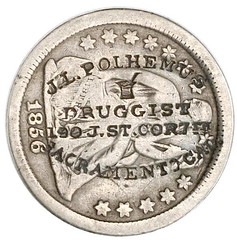 For years I collected U.S. merchant counterstamps by undertype, assembling a U.S. type set of sorts. Never had one of these, but I did have a Polhemus stamp on a dime. The smaller the coin the harder it is to stamp, and dimes, half-dimes and three-cent pieces were tougher to find. This was a nice J.L. Polhemus counterstamp on a dime, sold by American Numismatic Rarities June 2006.
-Editor
For years I collected U.S. merchant counterstamps by undertype, assembling a U.S. type set of sorts. Never had one of these, but I did have a Polhemus stamp on a dime. The smaller the coin the harder it is to stamp, and dimes, half-dimes and three-cent pieces were tougher to find. This was a nice J.L. Polhemus counterstamp on a dime, sold by American Numismatic Rarities June 2006.
-Editor
To read the complete article, see:
Treasure Talk: Episode 7 Part 2
Gold on a long voyage
(https://finestknown.com/treasure-talk-episode-7-part-2gold-on-a-long-voyage/)
For the complete series, see:
Category Archives: Treasure Talk with Bob Evans
(https://finestknown.com/treasure-talk-with-bob-evans/)
To read the earlier E-Sylum article, see:
TREASURE TALK WITH BOB EVANS, EPISODE 1
(https://www.coinbooks.org/v28/esylum_v28n12a12.html)
TREASURE TALK WITH BOB EVANS, EPISODE 2.1
(https://www.coinbooks.org/v28/esylum_v28n13a17.html)
TREASURE TALK WITH BOB EVANS, EPISODE 2.2
(https://www.coinbooks.org/v28/esylum_v28n14a15.html)
TREASURE TALK WITH BOB EVANS, EPISODE 3.1
(https://www.coinbooks.org/v28/esylum_v28n15a16.html)
TREASURE TALK WITH BOB EVANS, EPISODE 3.2
(https://www.coinbooks.org/v28/esylum_v28n17a16.html)
TREASURE TALK WITH BOB EVANS, EPISODE 4.1
(https://www.coinbooks.org/v28/esylum_v28n18a13.html)
TREASURE TALK WITH BOB EVANS, EPISODE 4.2
(https://www.coinbooks.org/v28/esylum_v28n19a20.html)
TREASURE TALK WITH BOB EVANS, EPISODE 5.1
(https://www.coinbooks.org/v28/esylum_v28n22a13.html)
TREASURE TALK WITH BOB EVANS, EPISODE 5.2
(https://www.coinbooks.org/v28/esylum_v28n23a16.html)
TREASURE TALK WITH BOB EVANS, EPISODE 6.1
(https://www.coinbooks.org/v28/esylum_v28n27a14.html)
TREASURE TALK WITH BOB EVANS, EPISODE 6.2
(https://www.coinbooks.org/v28/esylum_v28n30a21.html)
TREASURE TALK WITH BOB EVANS, EPISODE 7.1
(https://www.coinbooks.org/v28/esylum_v28n32a16.html)
NUMISMAGRAM MEDAL SELECTIONS: AUGUST 24, 2025
Numismagram's Jeremy Bostwick sent along these five medals from his most recent upload of new material to his site. For all of the new items, please visit https://www.numismagram.com/inventory. -Garrett
103198 | GERMANY. Saxe-Römhild. Heinrich III silver Medal. Issued 1698 for his receiving the Danish Order of the Elephant and the title Generalfeldzeugmeister (general of the artillery) by Holy Roman Emperor Leopold the previous year (50mm, 72.81 g, 12h). By Christian Wermuth. HEINRICVS • D • G • DVX SAX • I • C • M • A • & W •, draped and armored bust right // VTRVMQVE MERETVR, Heinrich standing facing, holding up scroll; crowned eagle above, holding scepter in talons; crowned Danish lion to right, holding collar chain of the Order of the Elephant; to left, pile of musical instruments and military implements; in five lines in exergue, CAESAR GENERALEM REI TORMEN / TARIAE PRAEFECTVM CONSTITVIT / AN MDCIIIC REX DANIAE IN / ELEPHANTIN ORD COO / PTAVIT MDCIIC. Wohlfahrt 98006; Merseburger –; Horn Coll. II, 222. PCGS AU Details–Scratch. Deeply toned and with a great deal of original brilliance among the fields, though some light rub on the high points and noted scratch in the reverse field account for the designation. Nevertheless, an extremely rare type, with this cataloger able to locate just one other specimen selling in the past quarter century—the Horn example, a very attractive uncirculated and problem-free piece which sold for a total of €10,800 ($12,244 at the time, after buyer's fee) in Künker 258 (29 January 2015), lot 222. $1,595.
To read the complete item description, see:
103198 | GERMANY. Saxe-Römhild. Heinrich III silver Medal.
(https://www.numismagram.com/product-page/103198)
103299 | UNITED STATES & GERMANY. Theodore Roosevelt uniface bronze Plaque. Issued circa 1912. Famous Men series (39mm x 50mm, 29.67 g). By Mayer & Wilhelm in Stuttgart. ROOSEVELT, facing bust in frock coat; below, laurel wreath and eagle, with Union shield on breast, wings spread, head left, and banner in beak (which billows overheard), standing facing // Blank. Edge: Plain. Bernd Kaiser V, 498 corr. (listed as Franklin Roosevelt); Serie berühmter Männer 94; Heidemann –. Choice Mint State. Olive-brown surfaces, with a pleasing matte nature. A rare portrait issue for the 26th president of the United States. $395.
To read the complete item description, see:
103299 | UNITED STATES & GERMANY. Theodore Roosevelt uniface bronze Plaque.
(https://www.numismagram.com/product-page/103299)
103224 | GERMANY. Ulm. Fisherman's Tournament silver Medal. Issued 1912 to commemorate the completion of the new bridge at the Gänsturm (33mm, 15.18 g, 12h). By Ferdinand Freiherr von Miller in Ulm. NEUE BRÜCKE AM GÄNSTOR / ÜBER DIE DONAU BEI ULM, veduta of Ulm, with the new bridge as the focal point; in three lines in exergue, OKTOBER 1910 BEGONNEN / VOLLENDET 1 JULI / 1912 // Water jousting scene featuring the Ulm sparrow against the winged tailor; ULMER FISCHERSTECHEN below. Edge: 950 SILBER. Nau 280; Wurster Coll. 2093; Heidemann –. PCGS SP-65. Intensely vibrant and glistening, with deep iridescent peripheral toning on both sides. An exceptionally stunning specimen. Tied with just one other example for the finest observed in the overall type in the PCGS census. $645.
To read the complete item description, see:
103224 | GERMANY. Ulm. Fisherman's Tournament silver Medal.
(https://www.numismagram.com/product-page/103224)
103213 | GERMANY, LATVIA & RUSSIA. Fall of Riga cast iron Medal. Issued 1917 (58mm, 49.84 g, 12h). By Karl Goetz in München. RIGA 1917, Russian bear lying on its back right, pierced by sword and wounded by the internal and external conflicts of 1914 through 1917, indicated on each limb // DER / FLÜGELSCHLAG / DER ZEIT (the wingbeat of the times), hourglass, indicating time has expired, held by scythe; chaotic revolutionary forces below. Edge: Some filing marks as made, otherwise plain. Kienast 195; Jones, Dance of Death, 39. PCGS MS-62. Glossy charcoal gray surfaces, with some alluring brilliance throughout. A scarce and popular type. $795.
Owing to its strategic position on the Gulf of Riga, the gulf's namesake city was of vital interest to its controlling Russian forces as well as those of the German Empire, who looked at it as a way to control the Baltic scene. If Germany were able to seize Riga, troops stationed near there could be then redeployed to the western front and France, where Germany believed the war would ultimately be decided. The battle was fought over three days at the beginning of September in 1917, with Germany eventually being victorious and capturing Riga, though the Russian 12th Army was able to escape and retreat. Internally, Russia herself was in turmoil, with Czar Nicholai II and the Romanov ruling family overthrown in February of that year and, just two months after the fall of Riga, the Bolshevik Revolution ("October" Uprising) would occur, sparking Russia's eventually fall to the hands of the Soviets. As indicated by Goetz on this medal, the Russian bear was bearing the wounds of multiple years' worth of internal and external conflicts.
To read the complete item description, see:
103213 | GERMANY, LATVIA & RUSSIA. Fall of Riga cast iron Medal.
(https://www.numismagram.com/product-page/103213)
103204 | FRANCE. Cinéma Art Deco bronze award Medal. Issued circa 1928 (68mm, 137.12 g, 12h). By Maurice Delannoy at the Paris mint. Nude female facing, emanating as a projection from an old movie projector; around her is an array of implements and instruments for various plotlines; CINEMA in exergue // Cinema screen between curtains and before seats; area of screen left blank for engraving. Edge: «cornucopia» BRONZE. Jones, Art of the Medal, 425. Mint State. Pleasing brown surfaces. A great type for the cinephile or fan of Art Deco. $295.
To read the complete item description, see:
103204 | FRANCE. Cinéma Art Deco bronze award Medal.
(https://www.numismagram.com/product-page/103204)
HERITAGE AUCTIONS: DESERT FIND OF 1889-CC MORGANS
Heritage auctions will be selling the Desert Find of 1889-CC Morgan Dollars as part of their ANA U.S. Coins Signature Auction on August 26-31. This find comprises of 35 previously unknown Brilliant Uncirculated 1889-CC Morgan Dollars. -Garrett
One of the greatest Morgan dollar finds of modern times will bring 35 previously unknown 1889-CC Morgan dollars, each in Brilliant Uncirculated condition, to the podium in Heritage's ANA U.S. Coins Signature® Auction August 26-31.
The Desert Find of 1889-CC Morgan Dollars features 35 Mint State 1889-CC Morgans, many of which are Prooflike to Deep Mirror Prooflike. Considering the Desert Find features coins that were set aside more than half a century ago by a family in Nevada, from whom they are consigned today, it is no surprise that the grades on the included coins are exceptional.
The coins appear to have been put into paper rolls, dated January 1957, and put away — quite possibly unseen since the 1950s or early 1960s.
The find includes 35 coins that came from two tubes, each of which originally held 20. The whereabouts of the remaining five coins is unknown.
"I got chills reading the report over and over, and couldn't wait to see them in person," says Greg Rohan, President of Heritage Auctions. "They were even better than I expected. I left our vault after the inspection wondering what had happened to the five missing coins from the two original rolls of 1889-CC dollars. Were they spent on the way home from the bank on groceries, a car repair? We'll never know."
Among the top selections in this magnificent trove is an 1889-CC Dollar MS64 Deep Mirror Prooflike PCGS. VAM-3 that is among the finest DMPL coins known. In a compilation of elite coins carrying higher-end grades of MS63 and MS64, this coin tops the list as the only example that grades MS64 Deep Mirror Prooflike. Not only is this the finest of the DMPL coins in the Desert Find, it is among the finest Deep Mirror Prooflike 1889-CC dollars known overall, including established pieces from traditional numismatic sources. In addition to its grade and potential high-end quality recognition, this magnificent piece is unique as the finest Deep Mirror Prooflike 1889-CC dollar from a landmark numismatic discovery that will long be remembered as one of the greatest of the 21st century.
Other highlights from this remarkable collection include, but are not limited to:
"A discovery like this is the sort of thing you might have occasionally expected during the mid-20th century," says Stephanie Sabin, President of Professional Coin Grading Service (PCGS). "The scope of this magnificent hoard is a thrilling discovery in the 21st century. In numismatics, you never know what's around the next corner, and this proves there is still much more to find. We are thrilled to have encapsulated the multitude of 1889-CC Morgan Dollars from this hoard. We're also excited to know that finds like these are still possible."
Heritage is an ANA Event Auctioneer Partner. Images and information about all lots in the Desert Find of 1889-CC Morgan Dollars, and all lots in the auction, can be found at HA.com/1385.
WYON FAMILY'S IMPACT ON COIN DESIGNS
The English Wyon family of engravers and medalists is responsible for some of history's finest coinage, and has had a significant impact on coin designs around the world. Here's an article by Zarine Parakh from the Heritage Intelligent Collector magazine. -Garrett
As a family of medalists in the 18th and 19th centuries, the Wyons retain a legacy of prominent artistry. While there are Wyon family members with pursuits as varied as sculptor, architect, lawyer, and rector, their skills as engravers and medalists are what earned their fame. Heritage's August 27-29 ANA World & Ancient Coins Platinum Session and Signature® Auction features treasures from a trio of Wyons: Thomas, William, and Leonard.


George III gold Pattern Sovereign 1816 PR64 Cameo NGC, by Thomas Wyon the Younger after Benedetto Pistrucci's model
Thomas Wyon the Younger began his career as an apprentice to his father, Thomas Wyon, chief engraver of the king's seals, before continuing his studies at the Royal Academy in London. This proved successful, as Thomas became a probationer engraver for the Royal Mint at just 19. While he first created designs for bank tokens, he continued to hone his skills until 1815, when he was promoted to chief engraver. With the prestige of this position came responsibility, as he was chief engraver during the great recoinage of 1816. The 1816 piece on offer at Heritage is a gold Pattern Sovereign featuring the likeness of George III, engraved by Thomas based on Benedetto Pistrucci's jasper cameo of the king and the first of its kind to be offered by the auction house. Thomas' vibrant career was cut short in 1817, when he succumbed to consumption that September at only 25 years old. His brief career yet clear talent for engraving enhances the allure of his pieces, including the 1816 Pattern Sovereign available at Heritage, which further enchants due to its pondlike fields, razor-sharp devices, and harvest-gold glow. The history of this piece is palpable, as its incredible preservation teleports the handler back to the day it was struck during such a prominent year in numismatics.
Thomas' father was an esteemed medalist himself, having gone into business with his brother, Peter Wyon, in Birmingham engraving tokens such as those in the Coventry series. Peter's son (Thomas' cousin) was William Wyon, arguably the most famous engraver of the family. William's life took a pivotal turn when Thomas Sr. invited him to London, where Thomas Sr. was working as an engraver for George III. William was awarded multiple prizes by the Royal Academy and the Society of Arts during his time in London, and in 1816 he secured the spot of second engraver, despite concern over his kinship with the newly appointed chief engraver, Thomas the Younger. The cousin duo overlapped at the Royal Mint for only a year before Thomas' death, after which Pistrucci was brought on full-time to fill the vacant role.
During William's tenure as second engraver, which lasted more than a decade, he engraved dies for the Guanajuato mint's 8 Reales. These pattern pieces were struck at the Royal Mint in London before the coins and dies were sent to Mexico, where they would be seized at the port of Veracruz as contraband due to the Mexico City mint's monopoly on coin manufacture in the region. The design of these 8 Reales was inspired by the Mexico City version yet leaned into Wyon's preferred Neoclassical style. The rays of the Cap and Rays motif were shorter, fully encircling the Libertad cap, adding a whimsical feel to the iconic image. The silver Proof Pattern 1827 issue available at Heritage bears hallmarks of William's fervent attention to detail, which comes through in the bold strike and precise devices; the meticulous lettering used in the legends retains clarity as ornate denticles draw the eye around the design. One can hardly imagine a bewitching specimen such as this traversing the globe hundreds of years ago and yet remaining in near pristine condition. In addition to this incredible Pattern of 1827, Heritage is offering a Hermosillo Pattern of 1882, thought to be struck from William's dies over 50 years later.
In 1828 William became chief engraver in his own right, and his talent as an engraver spanned three British monarchs. He was commissioned in 1830 to design the coronation medal of William IV based on Francis Chantrey's bust. The Proof 1831 medal featured in Heritage's August auction is one of just 965 surviving gold pieces from the original 1,203 that were distributed at the coronation by the treasurer of the household or sold to the public by the Mint office and various Messrs. William also engraved the 1839 £5 "Una and the Lion," perhaps his most notable work, to commemorate the beginning of the young Queen Victoria's reign. Based off Edmund Spenser's poem The Faerie Queene, Victoria features as the titular character, Una, guiding a lion. Serving as an allegory to foretell the queen's success as a monarch, the lion is meant to represent the British Empire, with Una a representation of the Church of England. Seen as a masterpiece of British numismatics, the design melds the beloved English tale with the new queen's rise to power. It's a momentous visual in any grade of preservation, and Heritage is offering an unbelievable four Una 1839 £5 Proof specimens, including this Mint State representative. The opportunity to own such a beautiful yet controversial piece is scarce, sure to incite engagement when one considers this is the first time a monarch was depicted on coinage as a fictional character.


Victoria gold Proof Sovereign 1839 PR65 Deep Cameo PCGS, featuring the young bust of the queen by William Wyon
William went on to serve Queen Victoria with his work on the "young head" bust design and the "Gothic" Crowns. Young head Proofs are now considered a symbol of Victoria's reign, certainly in no small part due to William's ethereal depiction of her. The bust was featured in Victoria's first Proof Set in 1839, which also included Una and the Lion. Heritage's August auction offers these Key Date pieces in veritable Proof and Proof Cameo grades, including this beautiful Gem masterpiece. William continued to create bold and magnetic coinage for the queen, next with his Gothic Crown. Minted in small numbers, the Gothic Crown is alluring in both rarity and historical value. William was at what could be considered the peak of his career, though during a turbulent time in British history, with the rise of the Industrial Revolution and Victorian Gothic. Tied to Romanticism, the Gothic style diverged from the Neoclassical and Georgian norms through its incorporation of architectural drama, intricate ornamentation, and the revival of medieval aesthetics. Marked by opulent, emotive, and mysterious motifs, this period saw the rise of spiritualism and interest in the occult. William encapsulates this moment of societal change with a dramatic design on the reverse of the Crown. One of this author's personal favorite types, a number of Proof Crowns are represented in Heritage's August auction, including this alluring near-Gem example.


Republic gold ‘Coarse Beard' Burgers Pond 1874 UNC Details (Obverse Repaired) NGC, by Leonard Charles Wyon
A few years prior to the minting of these bewitching Gothic pieces, William's son, Leonard Charles Wyon, at the age of 17, also began work at the Royal Mint. Leonard was second engraver under his father for many years, up until William's death in 1851. Known primarily for his medals and overseas issues, Leonard engraved a number of dies for the British military and navy. He inherited his father's skill in portraiture, as seen in Leonard's representation of South African President Thomas François Burgers. The first coin of the South African Republic, the "Burgers" Pond was struck at Heaton mint in 1874. Leonard seemed to have a penchant for deep engraving, as dies would break and necessitate replacement. This is perhaps the case with the "Coarse Beard" and "Fine Beard" Burgers Ponds, as the first issues feature a finer beard, while the issues post die-break display coarse facial hair. Heritage is offering both varieties in remarkable preservation, transporting the viewer through time to the far corners of the British Empire.
One of the most exciting parts of Heritage's ANA Platinum and Signature® Auction is the convergence of incredible numismatic and world history with the visual enchantment of elite craftsmanship and preservation. While here we touched on just a few of those histories through the lives and careers of the Wyon family, there are countless other stories waiting in the August 29 auction. Perhaps the next step in these masterpieces' histories will be finding a new home in your collection.
To read the complete article, see:
Mint To Be: How the Wyon Family Left Its Mark on Coin Designs Around the World
(https://intelligentcollector.com/mint-to-be-how-the-wyon-family-left-its-mark-on-coin-designs-around-the-world/)
To read the earlier E-Sylum article, see:
NEW BOOK: WILLIAM WYON
(https://www.coinbooks.org/v28/esylum_v28n18a03.html)
STACKS BOWERS: SUMMER 2025 GLOBAL SHOWCASE
Stack's Bowers will be holding their annual Global Showcase Auction of World and Ancient coins between August 25 and September 5. Here is the press release. -Garrett
Stack's Bowers Galleries' annual Global Showcase Auction of World and Ancient coins will feature nearly 5,500 lots, encompassing an expansive range of material across nine sessions, with a high estimate that exceeds $10 million. The live auctioneer-led sessions will be held August 25, 26, 28 and 30, with the internet sessions taking place September 2-5.
The Richard August Collection offers interesting and desirable selections from the cabinet of this respected numismatist and familiar presence at coin shows, especially around New England. Among his world coin holdings, Mr. August's British Isles coins are particularly notable for their quality and include a Great Britain 1668 5 Guineas and a stunning 1601 British Crown graded AU-55 by NGC. Also worthy of mention from the Richard August Collection is a charmingly struck and detailed Bolivian "Royal" Presentation Cob 8 Reales.
The Hough Family Collection comprises exceptional American rarities as well as stunning European gold issues. Highlights among the world coins include a tremendously rare Commonwealth 50 Shillings 1656 Pattern graded Proof-62 Cameo (PCGS), an extremely rare 1643 Triple Unite graded MS-61 (PCGS), and a remarkable PCGS Proof 63+ 1826 Great Britain 5 Pounds.


FRANCE. Kingdom. Silver Ecu de Calonne Essai (Pattern), 1786-A.
Paris Mint. Louis XVI. PCGS SPECIMEN-61.
A group of rare and ephemeral items from the turbulent period of Napoleon Bonaparte's rise and fall will be presented in Part IV of the Richard Margolis Collection on August 30. Fascinating pieces include a rare 1793-M Louis d'Or de 24 Livres, an impressive 1815-A Gold 40 Francs Essai, and a 1786-A Silver Ecu de Calonne Essai, among other French numismatic-related lots.


SICILY. Syracuse. Dionysios I, 406-367 B.C.
AV 100 Litrai (Double Dekadrachm) (5.80 gms), ca. 400-370 B.C.
NGC AU, Strike: 5/5 Surface: 3/5.
Aside from the major collections, spectacular individual lots include a PCGS MS-62 certified quadruple thick 1742 2 Talers from Germany and a striking Philippines countermark applied to a French Ecu of Louis XV (a rare host for the countermark). Ancient numismatics offers several eye-catching lots, including a well-struck Ch F Strike: 5/5 Surface: 4/5 Marc Antony & Octavia AV Aureus, as well as an appealing AU Strike: 5/5 Surface: 3/5 Syracuse AV 100 Litrai from 400 B.C. Also notable is a rare Judaea AR Half Shekel certified by NGC as EF Strike: 4/5 Surface: 4/5, which would be an exquisite addition to any advanced Judean collection.
The entire Stack's Bowers Galleries Summer 2025 Global Showcase Auction is available for viewing and pre-sale bidding at StacksBowers.com. The firm is currently accepting consignments for their fall 2025 auctions and 2026 Showcase events. To include your coins, medals, tokens, and paper money in an upcoming auction, contact Stack's Bowers Galleries by telephone at 800-458-4646 or by email at Consign@StacksBowers.com.
Other highlights from the Stacks' Bowers Galleries Summer 2025 Global Showcase Auction include:
- GERMANY. Esslingen. 5 Ducats (1/2 Portugaloser), 1717. Augsburg Mint. Free City. NGC MS-63.
- GREAT BRITAIN. Silver "Bonomi" Crown Pattern, "1837" (ca. 1893). Victoria. NGC MS-65.
- GUATEMALA. Central American Republic. Mint Sport -- Silver Double Denomination -- 8 Reales/8 Escudos Mule, "1824"-NG A (After 1847). Nueva Guatemala Mint, Assayer "A". NGC AU-55.
- ITALY. Venice. Gold Osella of 3 Zecchini Weight, 1781. Venice Mint. Paolo Renier. PCGS MS-62.
- JAPAN. Oban (10 Ryo), ND (1860-62). Man'en Era. PCGS MS-62.
- MEXICO. 4 Escudos, 1734/3-Mo MF. Mexico City Mint. Philip V. PCGS MS-62.
- NETHERLANDS. Holland. Gold Gulden, 1681. NGC PROOF-64 Cameo.
- POLAND. Danzig. Ducat, 1551. Danzig Mint. Sigismund II Augustus. PCGS MS-61.
- PORTUGAL. 1/2 Espadim, ND (1458-81). Lisbon Mint. Afonso V. PCGS Genuine--Environmental Damage, EF Details.


GUATEMALA. Central American Republic. Mint Sport --
Silver Double Denomination -- 8 Reales/8 Escudos Mule, "1824"-NG A (After 1847).
Nueva Guatemala Mint, Assayer "A". NGC AU-55.
STACK'S BOWERS: COLLECTORS CHOICE TOKENS & MEDALS
Stack's Bowers will be hosting their September 2025 Collectors Choice Online Auction of tokens and medals on September 15 and 16. Select items are discussed below. -Garrett
Undated (1847) State of Louisiana Medal to Major General Zachary Taylor. Julian MI-25. Copper. About Uncirculated, Edge Bruise. Housed in the Original Case. 76.6 mm. Produced in antebellum New Orleans through contract with the firm of H[orace] E. Baldwin & Co., silversmiths, the dies were created by America's most famed medallist of the period - Charles Cushing Wright - with the design assistance of New Yorker Peter Paul Duggan, an historian and professor of drawing at New York's Free Academy. The same design team accomplished the Washington Allston medal struck by the Mint in this era. The military scene on the reverse is reminiscent of the finest work of Dupre or Furst and is glorious in its fine detail. It is unclear if H.E. Baldwin & Co. had the means to strike such a substantial medal themselves or subcontracted its actual coining.
Taylor received a gold striking and at least one in silver. Other silver medals were presented to Taylor's staff, while copper examples like this were probably either sold to collectors or distributed to other VIPs. Today, the silver and copper medals are similarly rare.
The original leather case is complete and functional, the only blemishes of note some minor exterior scuffing. (Total: 1 medal; 1 case)
To read the complete item description, see:
Undated (1847) State of Louisiana Medal to Major General Zachary Taylor. Julian MI-25. Copper. About Uncirculated, Edge Bruise. Housed in the Original Case.
(https://auctions.stacksbowers.com/lots/view/3-1L9IF9/undated-1847-state-of-louisiana-medal-to-major-general-zachary-taylor-julian-mi-25-copper-about-uncirculated-edge-bruise-housed-i)
"1777-1778" (ca. 1862) George Hampden Lovett's Headquarters Series Medal. No. 5, Valley Forge. Second Obverse. Musante GW-492, Baker-194-5A. Copper. MS-65 RB (NGC). 28.6 mm.
To read the complete item description, see:
"1777-1778" (ca. 1862) George Hampden Lovett's Headquarters Series Medal. No. 5, Valley Forge. Second Obverse. Musante GW-492, Baker-194-5A. Copper. MS-65 RB (NGC).
(https://auctions.stacksbowers.com/lots/view/3-1L9IYA/1777-1778-ca-1862-george-hampden-lovetts-headquarters-series-medal-no-5-valley-forge-second-obverse-musante-gw-492-baker-194)
"1852" Henry Clay Memorial Medal. Julian PE-8. Copper, Bronzed. About Uncirculated. 76 mm.
To read the complete item description, see:
"1852" Henry Clay Memorial Medal. Julian PE-8. Copper, Bronzed. About Uncirculated.
(https://auctions.stacksbowers.com/lots/view/3-1L9JQI/1852-henry-clay-memorial-medal-julian-pe-8-copper-bronzed-about-uncirculated)
1987 Cat and Mouse Medal. By Robert A. Weinman. Alexander-SOM 115.1. Bronze. Mint State. Housed in the Original Box. 69 mm x 55 mm, irregular. The original descriptive paper is also included. (Total: 1 medal; 1 box)
To read the complete item description, see:
1987 Cat and Mouse Medal. By Robert A. Weinman. Alexander-SOM 115.1. Bronze. Mint State. Housed in the Original Box.
(https://auctions.stacksbowers.com/lots/view/3-1L9K8S/1987-cat-and-mouse-medal-by-robert-a-weinman-alexander-som-1151-bronze-mint-state-housed-in-the-original-box)
1892 World's Columbian Exposition. Liberty Head Dollar. HK-222, SH 6-79 AL, Eglit-51. Rarity-3. Aluminum. Proof-65 Deep Cameo (PCGS). 35 mm.
To read the complete item description, see:
1892 World's Columbian Exposition. Liberty Head Dollar. HK-222, SH 6-79 AL, Eglit-51. Rarity-3. Aluminum. Proof-65 Deep Cameo (PCGS).
(https://auctions.stacksbowers.com/lots/view/3-1L9KQN/1892-worlds-columbian-exposition-liberty-head-dollar-hk-222-sh-6-79-al-eglit-51-rarity-3-aluminum-proof-65-deep-cameo-pcgs)
1853 Exhibition of the Industry of All Nations Award Medal. Harkness Ny-355, Julian AM-16. Bronze. MS-66 BN (NGC). 58 mm.
To read the complete item description, see:
1853 Exhibition of the Industry of All Nations Award Medal. Harkness Ny-355, Julian AM-16. Bronze. MS-66 BN (NGC).
(https://auctions.stacksbowers.com/lots/view/3-1L9LUC/1853-exhibition-of-the-industry-of-all-nations-award-medal-harkness-ny-355-julian-am-16-bronze-ms-66-bn-ngc)
1916-17 New York Numismatic Club Presidential Medal. F.C.C. Boyd. By Jonathon M. Swanson/VDB First Reverse. Bronze. No. 19. Mint State. 38.5 mm. From a mintage of 50 examples in bronze. Only one was struck in silver. A popular issue from one of the club's most famous numismatists.
Provenance: From the Harold S. Bareford Collection, Past President, New York Numismatic Club.
To read the complete item description, see:
1916-17 New York Numismatic Club Presidential Medal. F.C.C. Boyd. By Jonathon M. Swanson/VDB First Reverse. Bronze. No. 19. Mint State.
(https://auctions.stacksbowers.com/lots/view/3-1L9M98/1916-17-new-york-numismatic-club-presidential-medal-fcc-boyd-by-jonathon-m-swansonvdb-first-reverse-bronze-no-19-mint-state)
NEW YORK. New York. 1858 George H. Lovett. Miller-NY 495. White Metal. Plain Edge. MS-63 (NGC). 31 mm.
Provenance: From the Robert Kaprinski Collection.
To read the complete item description, see:
NEW YORK. New York. 1858 George H. Lovett. Miller-NY 495. White Metal. Plain Edge. MS-63 (NGC).
(https://auctions.stacksbowers.com/lots/view/3-1L9MY8/new-york-new-york-1858-george-h-lovett-miller-ny-495-white-metal-plain-edge-ms-63-ngc)
JERSEY PROPOSES NEW HERITAGE LAW ON HOARDS
The new Heritage Law proposed by the Government of Jersey provides clearer guidelines about the legal status of coin hoards found in Jersey. Legal ambiguity complicated the reporting of the Le Câtillon II hoard when it was found in 2012. -Garrett
A pair of metal detecting enthusiasts who unearthed almost 70,000 Iron Age coins said they were "very pleased" with proposals for a new law to make reporting and valuing treasure easier.
Richard Miles and Reg Mead made the discovery, which included gold and silver ingots and jewellery, in a field in Grouville, Jersey, in 2012.
However, they said there was confusion at the time over how to report their find - now dubbed Le Câtillon II - because there was no statute in place.
The proposed Heritage Law, brought forward by Government of Jersey, will provide more clarity, the hoard finders said.
Coin hoards, metallic objects more than 300 years old and made of at least 10% gold or silver, and groups of prehistoric metal objects, are among the archaeological finds classed as treasure by the UK's 1996 Treasure Act.
Jersey has no similar rules in place, which was highlighted by their find, said Mr Miles.
Under the new Heritage Law, any find more than 50% gold and silver, that has been hidden with the intention of returning, and has no known heirs, is declared treasure.
It must be reported to Jersey Heritage within 14 days and the eventual price will be based on expert advice and linked to the object's market value.
Mr Miles said: "My view is that the law is actually really good. It follows very closely what the best practice in the UK is.
"It looks after the finders, the landowners, it takes into consideration the Crown and heritage bodies, so really it's a win-win-win situation for everybody and is very fair."
To read the complete article, see:
Coin hoard finders 'pleased' with draft treasure law
(https://www.bbc.com/news/articles/cn02rng5495o)
To read the earlier E-Sylum article, see:
JERSEY GROUVILLE HOARD BEING DISMANTLED
(https://www.coinbooks.org/esylum_v17n35a32.html)
JERSEY GROUVILLE HOARD WAS TWO COLLECTIONS
(https://www.coinbooks.org/v22/esylum_v22n12a24.html)
JERSEY COIN HOARD FINDERS AWAITING REWARD
(https://www.coinbooks.org/v22/esylum_v22n14a25.html)
CORRECTIONS: GROUVILLE HOARD DETAILS
(https://www.coinbooks.org/v23/esylum_v23n07a13.html)
DR. STAHL VISITS JERSEY COIN HOARD
(https://www.coinbooks.org/v27/esylum_v27n21a21.html)
"RISING SUN" COINS REVEAL ANCIENT TRADE NETWORKS
"Rising Sun" coins, struck in north-central Myanmar during the first millennium AD, have revealed extensive economic integration that previous studies have not sufficiently documented. -Garrett
Archaeologists obtained new insights into early Southeast Asian trade and cultural connections through an extensive examination of silver coins dating to as early as the fourth century CE. Carrying distinctive Rising Sun and Srivatsa designs, the coins were widely in circulation across the region—from Vietnam to Bangladesh—demonstrating a level of economic integration that has rarely been the subject of previous historical studies of the region.
The coins, originally struck by the north-central Myanmar's Pyu-Mon polities, were produced with dies—molds that imprint designs onto both sides of a blank disc. While there are slight variations in diameter, weight, and imagery, their overall uniformity suggests strict standardization. This consistency, scientists assert, indicates shared economic and cultural systems that transcended local political boundaries.
Chinese chronicles from as early as the late Han Dynasty (second century CE) recorded Southeast Asia's role in sea and land-based trade routes connecting the Near East to China via the Persian Gulf, Indian Ocean, and South China Sea. Archaeological excavations have confirmed these accounts, with imported artifacts such as Roman glassware, Persian and South Asian ceramics, Indian jewelry, and Chinese ceramics discovered in both coastal trade ports and inland settlements. Of these finds, the Rising Sun/Srivatsa coins stand out for their exceptional geographic spread, having been found within the Irrawaddy River basin in Myanmar, Dvaravati culture centers in Thailand, Funanese centers in the Mekong Delta, and even riverine settlements along the Malay Peninsula.
Dr. Andrew Harris of the National University of Singapore and colleagues conducted a die study of 245 coins from museums in Myanmar, Cambodia, Vietnam, and Thailand. They discovered over one obverse and reverse die match on coins that are thousands of kilometers apart. In a remarkable case, the obverse sides of coins from Bangladesh and Vietnam both appear to have been produced with the same die—suggesting they most likely were minted by the same authority or even the same artisan, despite the locations being thousands of miles apart.
Beyond their historical importance, the researchers point to the importance of die studies as a weapon against illicit antiquities trafficking. Many ancient coins from Myanmar have been looted during the ongoing conflict, sold into private collections, or melted down. By means of coin provenance tracing, die studies can identify forgeries and preserve the cultural heritage of the region.
To read the complete article, see:
Ancient ‘rising sun' coins reveal vast first-millennium trade networks across Southeast Asia
(https://archaeologymag.com/2025/08/ancient-coins-reveal-vast-trade-across-southeast-asia/)
Ted Banning sent in a link to the original paper. Here's an additional image. Thank you. -Editor
To read the complete paper, see:
Currents of currency: utilising die studies to trace Rising Sun/Srivatsa coin distribution in first-millennium AD Southeast Asia
(https://www.cambridge.org/core/journals/antiquity/article/currents-of-currency-utilising-die-studies-to-trace-rising-sunsrivatsa-coin-distribution-in-firstmillennium-ad-southeast-asia/D230C1E8E1D8F71B8E4E5B7D31885C91)
U.K. HER ROYAL HIGHNESS COMMEMORATIVE
The U.K.'s Royal Mint recently revealed a new commemorative coin celebrating the 75th birthday of Her Royal Highness The Princess Royal, marking the first time Princess Anne has been honored on an official UK coin. Thanks to David Pickup for passing this along. -Garrett
The Royal Mint has today revealed the first UK coin to celebrate Her Royal Highness The Princess Royal. The commemorative coin has been released in the year in which she will celebrate her 75th birthday, marking her remarkable lifetime of service.
The coin's design, personally approved by Her Royal Highness, has been created by renowned Royal Mint coin designer Thomas T. Docherty, who previously designed HRH The Prince of Wales's 40th birthday coin. Thomas' coin design features a striking portrait of The Princess Royal and is based on an official portrait of The Princess Royal taken by John Swannell, a fellow of the prestigious Royal Photographic Society. In the portrait, Her Royal Highness has also been depicted wearing the Aquamarine Pineflower Tiara which was created by Cartier.
The design is framed with the inscription "The Princess Royal - Celebrating 75 Years - Duty and Devotion" - a fitting tribute to her lifetime of service to the Crown and nation. To the right of The Princess Royal's portrait features a depiction of The Princess Royal's official Coat of Arms.
Rebecca Morgan, Director of Commemorative Coin at The Royal Mint, said: "For the first time in British numismatic history, we are honoured to celebrate The Princess Royal on an official UK coin. Her Royal Highness's unwavering commitment to public service, charitable work, and support of His Majesty's Armed Forces over seven and a half decades makes her truly deserving of this tribute. The graceful design by Thomas Docherty perfectly captures both her dignified presence and extraordinary legacy while also celebrating The Princess Royal's 75th birthday."
Thomas T. Docherty, Coin Designer at The Royal Mint and designer behind the coin said, "It has been an honour to create this commemorative coin celebrating The Princess Royal's 75th birthday. In designing this piece, I wanted to capture Her Royal Highness's remarkable legacy and dedication to public service. The portrait reflects her strength of character and unwavering commitment to duty. Being Scottish, I admire The Princess Royal's dedication to Scottish organisations and communities, and I hope this coin serves as a fitting tribute."
In recent years, The Royal Mint has honoured several notable royal birthdays with commemorative UK coins, including Queen Elizabeth II's 95th birthday, His Majesty King Charles III's 70th and 75th birthdays as well as HRH The Prince of Wales's 40th birthday. Each coin represents not only The Royal Mint's technical excellence and artistic innovation but also serves as a tangible piece of British history, allowing collectors and royal enthusiasts alike to participate in these national celebrations.
Throughout her 75 years, The Princess Royal has built an extraordinary legacy of public service supporting The Monarch. As one of the hardest working members of the Royal Family, Her Royal Highness regularly undertakes over 500 engagements annually. The Princess Royal's remarkable achievements include her pioneering role as the first British Royal to compete in the Olympic Games and her presidency of Save the Children UK since 1970, travelling extensively to support their humanitarian work in over 70 countries as well as her longstanding patronage of over 300 charities and organisations, spanning causes from maritime and transport to science and health.
The commemorative coin will be available to purchase from The Royal Mint's website on 18th July, with prices starting from £17.50 for the brilliant uncirculated edition. Other versions of the coin will also be available in silver and gold proof finishes.
To read the complete article, see:
A Royal First: Royal Mint Celebrates The Princess Royal With ‘Anne-iversary' Coin
(https://www.royalmint.com/aboutus/press-centre/a-royal-first-royal-mint-celebrates-the-princess-royal-with-anne-iversary-coin/)
DISABILITY COMMUNITY CELEBRATES MILBERN QUARTER
On August 13, disability activists celebrated the release of the Stacy Park Milbern quarter, part of the American Women Quarters Program. -Garrett
 On Wednesday, August 13, disabled people and allies gathered at the National Museum of American History to celebrate the release of a new quarter depicting Stacey Park Milbern, a leader of the disability justice movement. She is the 19th woman honored as part of the American Women Quarters Program, which celebrates the accomplishments and contributions made by women throughout American history.
On Wednesday, August 13, disabled people and allies gathered at the National Museum of American History to celebrate the release of a new quarter depicting Stacey Park Milbern, a leader of the disability justice movement. She is the 19th woman honored as part of the American Women Quarters Program, which celebrates the accomplishments and contributions made by women throughout American history.
The event's program partners included the United States Mint, National Museum of American History, American Women's History Museum, Access Smithsonian, Asian Pacific American Center, Disability Cultural Center at Georgetown University, and the American Association of People with Disabilities (AAPD). Many of the partners tabled for the first hour of the event.
Stacey Park Milbern, whose Korean name was Park Ji-hye, led and strengthened the modern Disability Justice movement. She had congenital muscular dystrophy and died on May 19, 2020, on her 33rd birthday. She was an activist, writer, speaker, and movement organizer who focused on the issues faced by queer and Black, Indigenous, and People of Color (BIPOC) disabled people.
The program began and ended with a traditional Korean fan dance performed by DI DIM SAE Korean Traditional Art Institute to honor Milbern's Korean heritage. Beth Ziebarth, Director of the Smithsonian's Office of Visitor Accessibility, then welcomed attendees to the event and introduced Dr. Elizabeth Babcock, Director of the Smithsonian American Women's History Museum.
"These coins help tell the story of our nation through the remarkable women that helped shape it, and we're proud to help lift up stories like Stacey's, stories that haven't always been included but deserve to be known," Babcock said.
Milbern's parents and siblings gave remarks on what this honor meant to their family. They shared a few examples of the many ways Milbern devoted herself to disability justice: she advocated for power companies to protect disabled people during power outages, formed an emergency response network during the peak of the COVID-19 pandemic, visited people with disabilities in institutions, and provided support as they transitioned to community living.
Greg Dawson, Associate Director of the Office of Strategy and Performance at the United States Mint, spoke more about the American Women Quarters program. He discussed the quarter's design, as imagined by Elana Hagler and sculpted by Craig Campbell.
"The Stacey Park Milbern quarter design depicts Milbern in action, speaking to an audience, one hand resting near her trach and the other stretched out palm-up in a gesture meant to evoke a genuine exchange of ideas and the building of allyship. The design captures Milbern's authenticity and reminds us that her voice was not just symbolic. It was strategic, thoughtful, and vital in building a more inclusive world," he said.
Program participants then joined Dawson on stage as 2000 quarters were poured into a display featuring a traditional Korean serving table and serving tray that Milbern used as a child. The United Mint has shipped the Milbern quarters to Federal Reserve Banks and coin terminals nationwide, with plans to produce 300 million to 700 million coins in total.
Ziebarth moderated a panel about disability justice featuring Yomi Young, former Executive Director of the Center for Independent Living in Berkeley, California, where Stacey worked, and Michelle Banks, Co-founder and Artistic Director of Visionaries of the Creative Arts (VOCA).
Attendees described the event as meaningful, hopeful, and exciting. For many, Milbern's quarter is not the final step in commemorating her life, but a new beginning.
"I left the event excited, thinking of all of the people who will learn about Stacey and disability justice for the first time as a result of these quarters, and just like she did in life, Stacey will facilitate folks' connection to community and their embrace of dreams they did not previously think were possible."
To read the complete article, see:
Disability Community Gathers to Celebrate Release of U.S. Quarter Featuring Activist Stacey Park Milbern
(https://www.aapd.com/stacey-park-milbern-quarter-event-recap/)
SWISS NATIONAL BANK SURVEYS NOTE DESIGNS
The Swiss National Bank (SNB) has unveiled a dozen potential designs for new banknote series and is now seeking the public's feedback via an online survey. -Garrett
At a time when established electronic payment methods are increasingly dominating everyday transactions—and with new digital payment options such as cryptocurrencies, stablecoins, and Central Bank Digital Currencies (CBDCs) emerging—the Swiss National Bank is pushing ahead with its «New Banknote Series Project» for many good reasons.
On Wednesday, it published the designs for the new series and launched a survey allowing the public to rate them. In February, the SNB selected twelve teams or individuals (names published) from over 300 applications submitted in response to its design competition. These selected entrants had until the end of July to submit their proposals (as previously reported by finews.com).
These twelve designs are now available (anonymized) on the dedicated SNB website. As promised at the end of October 2024, for the first time ever the public can share their views on them. The online survey, conducted by polling institute Demoscope on behalf of the SNB, is open from now until September 7, 2025.
The SNB plans a two-stage process: in the first round, the designs will be evaluated by the public as well as by an advisory board of external experts. The six best designs will then advance to the second round, which will focus on «potential collaboration and commercial aspects.
To read the complete article, see:
Swiss National Bank Launches Online Survey on Banknote Designs
(https://www.finews.com/news/english-news/68826-neue-banknotenserie-banknotenentwuerfe-umfrage-snb-nationalbank-gestaltungswettbewerb-2)
To view all twelve potential designs, see:
Swiss National Bank Design Concepts
(https://www.neuebanknotenserie.ch/detailview.html?lang=en)
OZZY OSBOURNE TRIBUTE BANKNOTES
Dudley, UK artist Dion Kitson has created murals and banknote designs dedicated to Ozzy Osbourne. Here's an excerpt - see the complete article online. Found via News & Notes from the Society of Paper Money Collectors (Volume XI, Number 9, August 12, 2025). -Garrett
As well as pasting a 12ft mural on a building in Broad Street the day before Ozzy's funeral, he has created a series of commemorative banknote designs in tribute to the Black Sabbath singer, with 30 per cent of the proceeds from each sale going to Parkinson's UK.
And the £5, £10 and £20 notes, which all feature different images of Ozzy, are flying off his website, with more than 1,000 sold already since they went online at the weekend. He has also created one dedicated to Ozzy's Black Sabbath bandmate Tony Iommi.
The banknotes are printed on cotton and linen paper with a security thread and a watermark.
Dion said: "Ozzy has obviously been in the news with his death prompting an outpouring of grief and tributes and thousands coming out to see his funeral cortege in Birmingham. where he was born and which I was at after doing a mural of him just days before.
"He deserves to be recognised so I thought I would create the designs as a homage to him and raise money for a cause that was dear to his and of course his family's heart.
"I think it is over 1,000 that have been sold, it seems to be one every minute - and they will remain on the website as long as they are selling and doing well for the deserving charity which is the most important thing."
At work one day recently I read a news headline and stood up to tell my officemates, "There's been a disturbance in the Force - Ozzy Osbourne died."
Back in the day I owned a copy of the Black Sabbath debut album, purchased after a friend introduced me to the band. I'm not a habitual jokester, but one night my Mom was having friends over for a card party, and she'd neatly stacked five or six of her albums on the record changer. Probably Perry Como, Jim Nabors or some such. I slipped Black Sabbath in the middle to enliven the party with a heavy metal surprise. Long live Ozzy! -Editor
To read the complete article, see:
'The People's Prince': Dudley artist pays tribute to Ozzy Osbourne with bank notes and mural
(https://www.expressandstar.com/entertainment/birmingham-entertainment/2025/08/11/the-peoples-prince-dudley-artist-pays-tribute-to-ozzy-osbourne-with-bank-notes-and-mural/)
ABOUT THIS ISSUE: AUGUST 24, 2025
With Garrett's help I managed to complete this issue while still attending the ANA convention this week. Thanks! And yeah, we prepared some of this issue in advance. I have a lot of material for a Diary article, but all that will have to wait. Meanwhile, thanks to all our readers and contributors for making The E-Sylum one of the top publications in the hobby. -Editor
Wayne Homren
Wayne Homren is the founding editor of The E-Sylum and a consultant for the Newman Numismatic Portal. His collecting interests at various times included U.S. Encased Postage Stamps, merchant counterstamps, Pittsburgh Obsolete paper money, Civil War tokens and scrip, Carnegie Hero Medals, charge coins and numismatic literature. He also collects and has given presentations on the work of Money Artist J.S.G. Boggs. In the non-numismatic world he's worked in artificial intelligence, data science, and as a Program Manager for the U.S. Department of Defense.
Garrett Ziss
Garrett Ziss is a numismatic collector and researcher, with a focus on American paper money and early U.S. silver and copper coins. He is also a part-time U.S. coin cataloger for Heritage Auctions. Garrett assists Editor Wayne Homren by editing and formatting a selection of articles and images each week. When he's not engaged in numismatics, Garrett is pursuing a Master's Degree in Quantitative Economics at the University of Pittsburgh.
Pete Smith
Numismatic researcher and author Pete Smith of Minnesota has written about early American coppers, Vermont coinage, numismatic literature, tokens and medals, the history of the U.S. Mint and much more. Author of American Numismatic Biographies, he contributes original articles to The E-Sylum often highlighting interesting figures in American numismatic history.
Greg Bennick
Greg Bennick (www.gregbennick.com) is a keynote speaker and long time coin collector with a focus on major mint error coins and US counterstamps. He is on the board of both CONECA and TAMS and enjoys having in-depth conversations with prominent numismatists from all areas of the hobby. Have ideas for other interviewees? Contact him anytime on the web or via instagram
@minterrors.
John Nebel
Numismatist, photographer, and ANS Board member and Fellow John Nebel of Boulder, CO helped the ANA and other clubs like NBS get online in the early days of the internet, hosting websites gratis through his Computer Systems Design Co. To this day he hosts some 50 ANA member club sites along with our
coinbooks.org site, making the club and our E-Sylum archive available to collectors and researchers worldwide.
Bruce Perdue
Encased coinage collector (encasedcoins.info) Bruce Perdue of Aurora, Illinois has been the volunteer NBS webmaster from its early days and works each week to add the latest E-Sylum issue to our archive and send out the email announcement.

